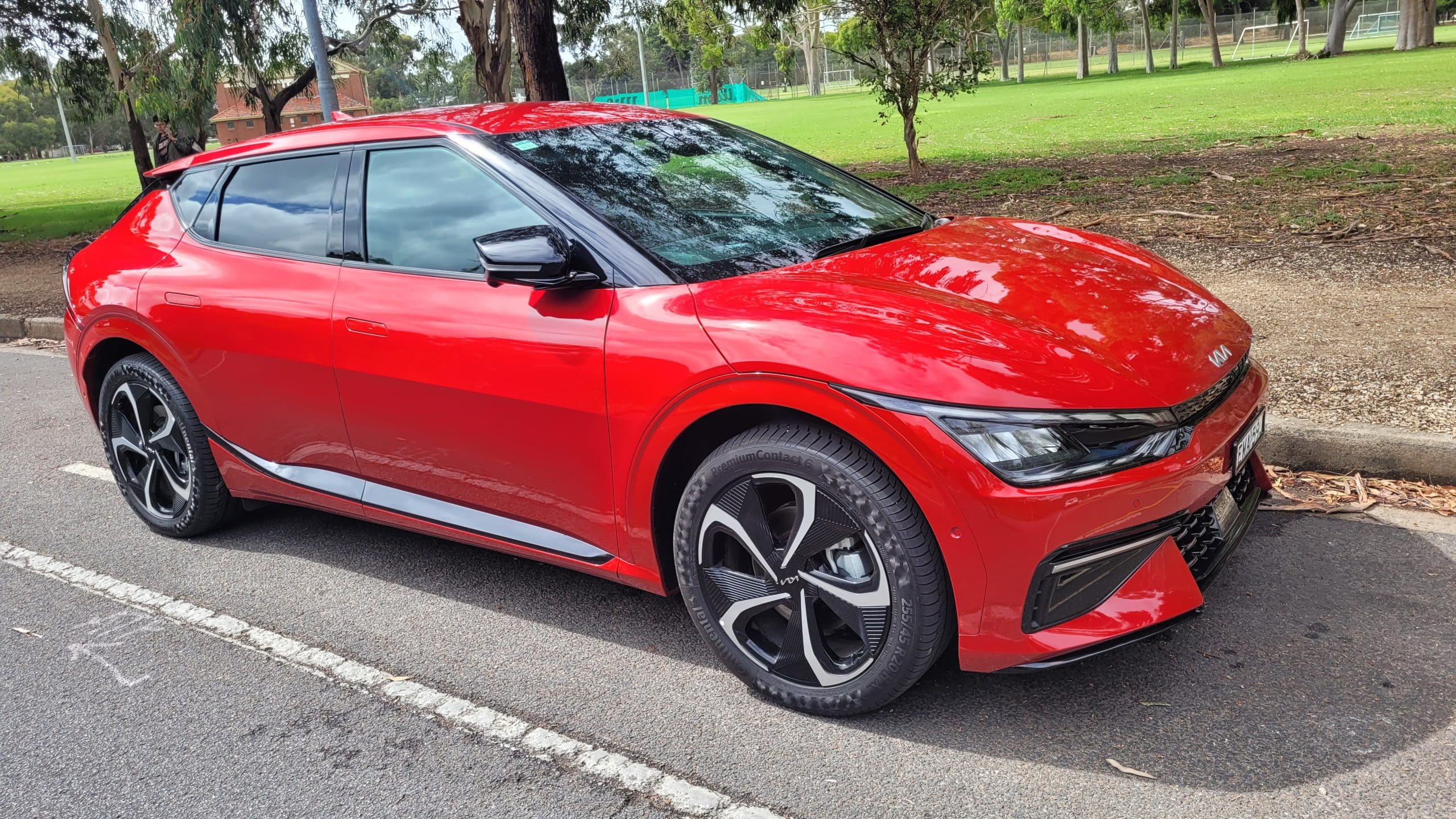In the market for an electric car or ute? Whether you’re shopping on a budget, looking for the longest range available, a model with all the latest tech or just something that has some zip, it’s crucial to do your research to determine which one is best for you.
To come up with our list of the best electric vehicles in Australia, we’ve taken into consideration EV models that we’ve test driven, their price, vehicle sales, battery range, charge time, safety rating and features.
It’s worth noting that EVs are also eligible for cheaper-rate green car loans, as well as big tax benefits through novated leasing. So, if you’re interested in any of these models, Savvy can assist you with your financing needs.
Dive right into our comprehensive breakdown today!
Cheapest electric cars in Australia: 2025
| Ranking | Model | Price from |
|---|---|---|
| 1 | BYD Dolphin | $29,990 |
| 2 | GWM Ora | $34,490 |
| 3 | Chery E5 | $36,990 |
| 4 | Leapmotor B10 | $37,888 |
| 5 | MG4 | $37,990 |
| 6 | Hyundai Inster | $39,000 |
| 7 | BYD Atto 3 | $39,990 |
| 8 | MGS5 EV | $40,490 |
| 9 | Geely EX5 | $40,990 |
| 10 | Leapmotor C10 | $43,888 |
| Excludes commercial vehicles. Prices reflect the lowest base price before on-road costs, sourced via CarsGuide. | ||
As of November 2025, the cheapest EV available in Australia is the BYD Dolphin, which starts from $29,990 before on-road costs. However, the Chinese manufacturer's latest budget option is soon to hit our shores and it's set to blow the Dolphin out of the water.
The Atto 1 will become the first official EV on sale in Australia under $30,000 (on-roads included) when it debuts at a base price of just $23,990. The Atto 2 will also be joining BYD's stable of EVs, with the soon-to-be-cheapest electric SUV starting at $31,990.
Best-selling electric cars in Australia: YTD 2025
| Ranking | Model | October YTD sales |
|---|---|---|
| 1 | Tesla Model Y | 17,972 |
| 2 | BYD Sealion 7 | 9,824 |
| 3 | Tesla Model 3 | 5,597 |
| 4 | Kia EV5 | 4,241 |
| 5 | Geely EX5 | 3,358 |
| 6 | BYD Atto 3 | 3,330 |
| 7 | BYD Seal | 3,214 |
| 8 | BYD Dolphin | 2,880 |
| 9 | MG 4 | 2,756 |
| 10 | Kia EV3 | 2,181 |
| Source: Federal Chamber of Automotive Industries and Electric Vehicle Council | ||
Table of contents
- Electric SUVs
- Electric hatches
- Electric sedans
- Electric utes
- Potential future electric ute arrivals
- Luxury electric vehicles
- Electric vans
- Other EVs coming soon
- Popular PHEVs in Australia: 2024
Electric SUVs
- Tesla Model Y
- MG MGS5 EV
- Hyundai Ioniq 5
- Kia EV6
- Genesis GV60
- Kia EV9
- Volvo EX40
- Chery E5
- BYD Atto 3
1. Tesla Model Y
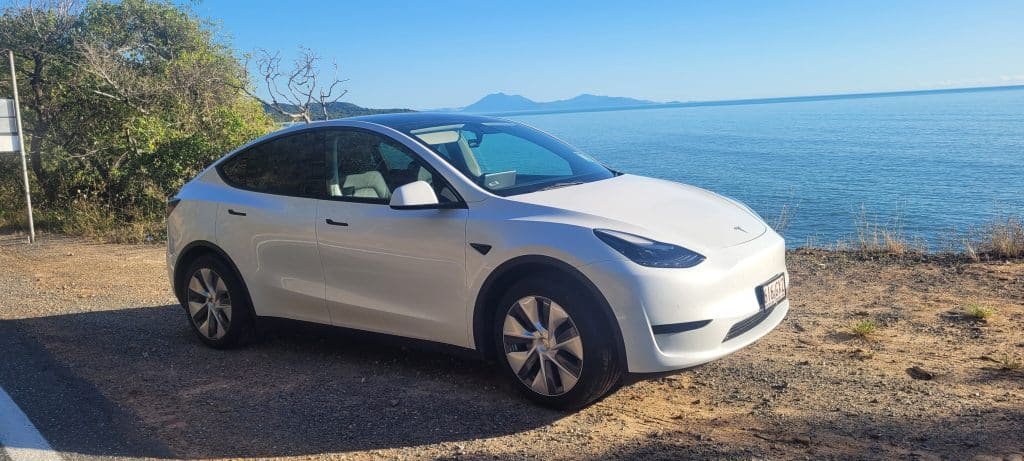
Test-driven: 11-14 August 2024 – by Adrian Edlington
"A short get-away to Cairns and Port Douglas in far north Queensland was the perfect opportunity to hire a Tesla Model Y and put it through its paces. The first thing I noticed was the unconventional controls. They were much different to any of the other EVs I’ve test-driven! I really should have taken the car rental employee up on their offer to show me how to operate the vehicle. As a result, I had to sit in the airport carpark and watch a few handy YouTube videos to learn my way around the controls. The built-in explainer videos did an equally good job, though I didn’t find them until later!
The main difference between a Tesla and other EVs is the absence of a standard dash. No traditional speedometer, either manual or digital, nor rev meter or heads up display, for that matter. The view through the steering wheel is of a completely smooth dash, which is quite novel.
All of the controls and functions are accessed through the central touch screen, which takes a little getting used to. However, I was able to adapt rather quickly. After a couple of days of driving, the car drove and handled like dream. The large and clear navigation map was a stand-out.
Where safety and smart driving features were concerned, it was pretty similar to most other EVs in terms of smart lane assist, adaptive cruise control, collision alert and more. I did notice the metal cruise control roller-button felt especially nice. It was easy to scroll up in 5km increments when slowing down or speeding up on the open road.
We found charging in Port Douglas convenient enough, as one of the hotels had 4 or more dedicated Tesla chargers. Our hotel had two, though one was out of action, while the other didn’t work for our vehicle. Driving north from Port Douglas to Cape Tribulation was easily achievable in a day without depleting the car’s battery beyond 45%.
If I were to buy one, I’d want the Long Range model, though your purchase decision will probably come down to two things: price and whether or not you like the sleek and minimalist interface. Be mindful of the fact that Tesla have slashed prices several times already to maintain competitiveness, while at the same time continuing to improve vehicle range, which could impact resale values."
- Minimum and maximum price: from $55,900 to $82,900
- Battery capacity: approx. 60kWh to 75kWh
- Range: up to 551km (Long Range AWD)
This is it: the most popular EV in Australia. American EV manufacturing giant Tesla’s Model Y is far and away the best-selling electric model on the market, with its 21,253 units sold across 2024 placing it more than 4,000 units ahead of the nearest challenger: its sedan counterpart, the Model 3. As of May 2025, it even ranks in the top five most popular medium SUVs, despite not having reported a single sale across that month.
The Model Y comes in three variants: the Rear-Wheel Drive (from $55,900), the Long Range (from $69,900) and the Performance (from $82,900), the latter of which is yet to hit our shores. The Long Range comes with the best distance per charge, as the name suggests, reaching up to 551km compared to the Rear-Wheel Drive (466km).
Tesla is secretive when it comes to factors like its engine capacity, power output, torque and charging times, so they can’t be compared as easily in these areas with other vehicles. However, with Tesla’s Autopilot technology, which includes a range of crucial safety technologies (though its five-star ANCAP safety rating lapsed in April 2025), and interior features such as a 15.4-inch touchscreen, it’s easy to see why many are making the jump to the Model Y.
2. MG MGS5 EV

- Minimum and maximum price: from $40,490 to $47,990
- Battery capacity: 49kWh to 62kWh
- Maximum power: 125kW/250Nm
- DC fast charge time (30% to 80%): approx. minimum 19 mins
- Range: up to 430km (MGS5 EV 62kWh Excite)
The MGS5 EV is the successor to the Chinese carmaker’s popular ZS EV, which has now been discontinued in Australia. Although not as cheap as the model it replaced in MG’s electrified SUV stable, it still rolls in at an affordable starting price of $40,490 for the base model, the 49kWh battery-powered Excite.
The range it offers isn’t anything ground-breaking, with up to 430km available through the 62kWh Excite and 425km with the 62kWh Essence. For the equivalent 49kWh variants, you’ll only be getting up to 340km and 335km, respectively.
However, one area of notable improvement for the MGS5 compared to the ZS EV is in the safety department. Each variant sports the full range of active and passive safety features, including:
- Intelligent Cruise Assist (ICA) and Speed Limit Assist (SAS)
- Blind Spot Detection (BSD)
- Rear Cross Traffic Alert (RCTA) and Braking (RCTB)
Couple those with some of the entertainment and comfort features like a 12.8-inch infotainment screen, Wireless and Wired Apple CarPlay and Android Auto and satellite navigation, you suspect the MGS5 EV has a bright future ahead of it on Australian roads.
We test-drove the MG ZS EV back in 2023. Watch our video review here.
3. Hyundai Ioniq 5
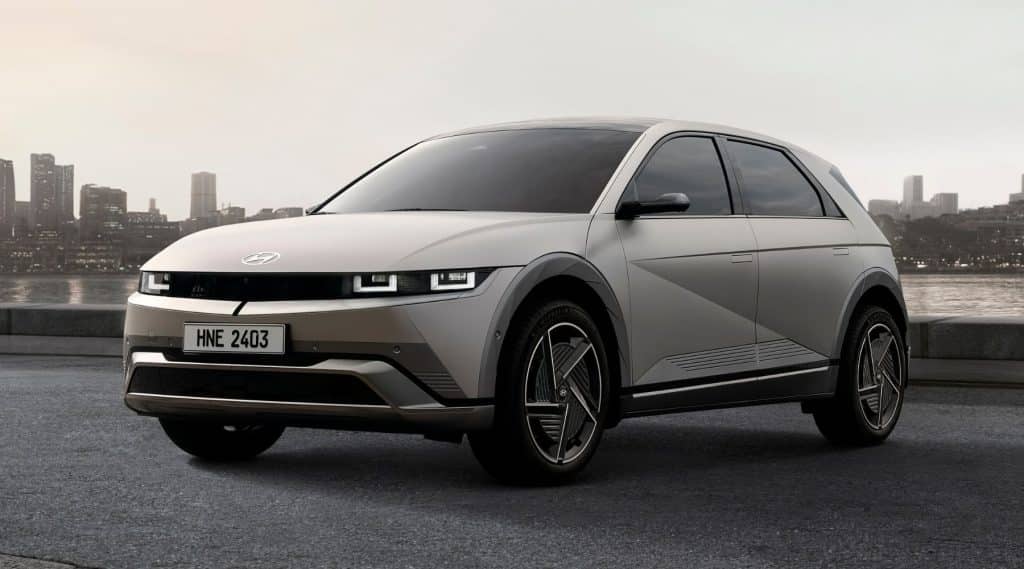
- Minimum and maximum price: from $69,800 to $91,800
- Battery capacity: 63kWh to 84kWh
- Maximum power: 255kW/605Nm
- DC ultra-fast charge time (10% to 80%, 350kW): approx. minimum 18 mins
- Range: up to 570km (Ioniq 5 Extended Range RWD)
Although previously South Korean manufacturer Hyundai’s best-selling EV model, the Ioniq 5 fell behind the electrified Kona in sales in 2024.
Its price point is a step up from the other SUVs we’ve been talking about, with the base Ioniq 5 starting at $69,800, the Dynamiq available from $80,800 and the Epiq from $84,300. While the base model is only available in RWD, the Dynamiq and Epiq both offer buyers the choice between RWD and AWD.
The Standard Range Ioniq 5 comes with the lowest battery capacity (63kWh) and range (440km) of all models, with the Extended Range variant and all versions of the Dynamiq and Epiq boasting an 84kWh battery. However, the base Extended Range boasts an impressive 570km in potential range to lead all variants. The AWDs pack the most power, coming in at 239kW and 605Nm of torque.
All models come with Hyundai SmartSense, which includes a variety of safety features such as:
- Parking Collision-Avoidance Assist – Reverse (PCA-R)
- Surround View Monitor (SVM)
Each model also comes with a 12.3-inch HD capacitive touchscreen display, Apple CarPlay and Android Auto compatibility and satellite navigation, while the Dynamiq and Epiq also come with an eight-speaker Bose premium speaker system.
It’s clear to see the appeal of the Ioniq 5. Its sleek design is instantly eye-catching and it offers a suite of attractive features in a spacious cabin that make your already comfortable driving experience that much more convenient.
4. Kia EV6

Test Driven: 8-15th March 2023 - by Adrian Edlington.
"The Kia EV6 was my personal favourite, alongside the Polestar 2. I drove the GT-Line (mid-spec) model for a week around urban Adelaide and through the hills and would personally like to own one.
The exterior looks really sleek and the coupe/hatch provided enough space for my mountain bike (wheels off and back seats down). There was ample legroom for the driver and the two front bucket seats were memorable.
The front dash and interior design feel kind of Knight Rider-ish: think dark with lots of glowing lights. I felt they were speaking to me as a consumer.
The performance was great - everything you'd expect from an EV at this price point. Something to be mindful of: with i-pedal regenerative braking, you don't need to use the brakes anywhere as much as in a regular vehicle. Hence, in any EV, super high-quality brakes aren't as much of a necessity as one might think.
- Minimum and maximum price: from $72,590 to $99,590
- Battery capacity: 77.4kWh
- Maximum power: 430kW/740Nm
- DC ultra-fast charge time (10% to 80%, 350kW): approx. minimum 18 mins
- Range: up to 528km (EV6 Air)
Kia’s EV6 was among the most popular EVs sold in Australia across 2024, with its 1,785 units enough to place it in the top ten, ahead of the electrified Niro variant (649), the EV5 (608) and the EV9 (568). The crossover SUV shares a platform with the Ioniq 5 and Genesis’ GV60, meaning there are similarities in its power and battery.
The first thing about the EV6 that’ll grab your attention is the design of the vehicle, striking the perfect balance between futuristic and traditional with its stylish exterior. It also boasts excellent legroom and a spaceship-like interior, thanks in large part to the aforementioned platform (the E-GMP platform).
The stumbling block for many Australians will be the price, with the base RWD Air model starting at $72,590, the GT-Line on offer from $79,590 (RWD) or $87,590 (AWD) and the AWD GT from $99,590.
However, what you get for that price is power. All models come with the same 77.4kWh battery, but while the Air and GT-Line’s single motors can reach up to 168kW and 350Nm, the GT-Line is capable of hitting 239kW and 605Nm (like the Ioniq 5’s AWDs) and the GT offers up to 430kW and 740Nm of torque.
You can also enjoy a variety of driver assistance technologies and safety features included as standard across the range, such as:
- Multi-Collision Braking (MCB)
- BCA (Blind Spot Collision Avoidance Assist) with RCCA (Rear Cross Traffic Collision Avoidance)
- Driver Attention Alert (DAA+) with Lead Vehicle Departure Alert
Ultimately, if you have the budget to buy it, you can grab one of the top EV SUVs in the country, which also includes a curved display with a 12.3-inch driver cluster and 12.3-inch infotainment touchscreen, satellite navigation and a 14-speaker Meridian sound system (GT-Line and GT only).
5. Genesis GV60
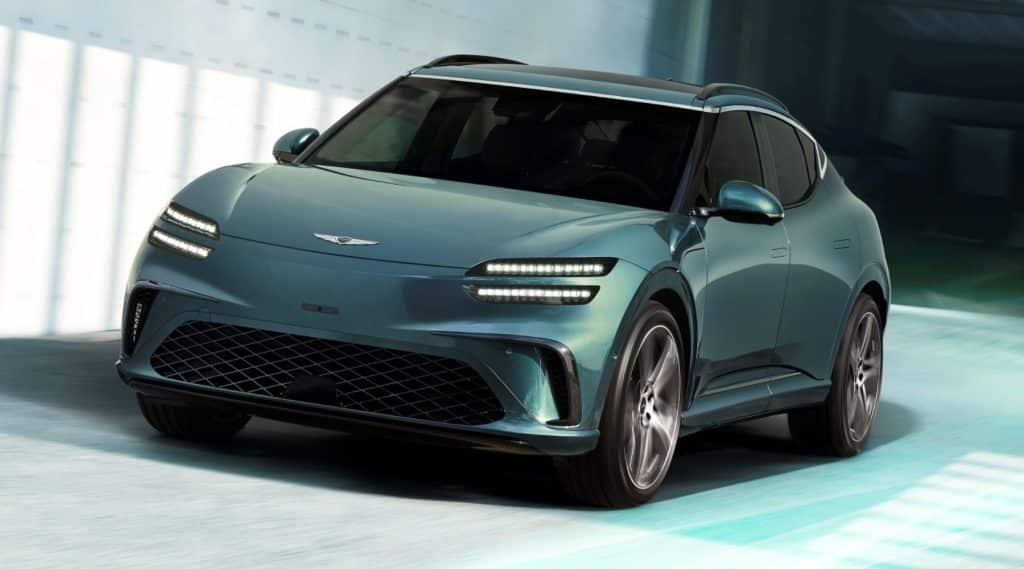
Test Driven: 1-8th March 2023 - by Adrian Edlington.
“I drove the top spec Genesis GV60 lime-green space-ship for a full week in 2023. Fair to say it's a very unique vehicle that will earn as many fans as detractors - though that's kind of the point. It aims and succeeds at being progressive and bold.
The GV60 has the most futuristic and lux interior of any EV I've driven, though borders on gimmicky in some ways (see the purple glowing drive selector knob that turns over like a magic-ball every time you start it up, or the camera side-mirrors that will cost $3k each to replace).
The pick-up and handling on the drive up Gorge Road from Adelaide was impressive: it hugs the road and always felt like it would be happy going much, much faster. The steering-wheel-mounted boost button makes it formidable. You can drag super bikes off at the lights and leave them in your dust.
If you're happy parting with over $115k for an EV and want something with personality, the GV60 may be right for you, though keep in mind the cream interior won't mix well with food, drinks, kids or pets."
- Minimum and maximum price: from $103,384 to $113,384
- Battery capacity: 77.4kWh
- Maximum power: 360kW/700Nm (with boost on GV60 Performance AWD)
- DC ultra-fast charge time (10% to 80%, 350kW): approx. minimum 18 mins
- Range: up to 470km (GV60 AWD)
Luxury carmaker Genesis’ first foray into a dedicated EV model was the GV60, which hit the market in 2023. With a starting price of $103,384 for the base model and the second variant, the Performance AWD, starting at $110,384, the GV60 range has decreased slightly in cost since its introduction.
It’s constructed using the same platform as two of the previous models on this list, the Ioniq 5 and EV6, though its maximum battery power (77.4kWh) is lower than those of the models from its parent and sister company, respectively.
However, when buying a luxury SUV, you’ll want to know two main things: how it drives and the features it can offer you. Fortunately, the GV60 is a balanced vehicle which offers superb ride quality and packs a powerful punch with up to 360kW of power and 700Nm of torque (if you use the boost on the Performance AWD).
It doesn’t scrimp on the tech, either. The GV60 comes with Face Connect for unlocking the car, as well as fingerprint recognition start, while it also boasts 12.3-inch displays for a Digital Instrument Cluster and an HD Multimedia touchscreen display. All models additionally come with a 17-speaker Bang & Olufsen sound system and a vision panoramic roof.
In terms of safety, you can experience some of the following features:
- Digital side mirrors
- Intelligent Front Lighting System (IFS)
The GV60 is bound to leave an impression on you if you get the chance to take it for a spin, though the price range will put it out of reach for the average Australian.
6. Kia EV9
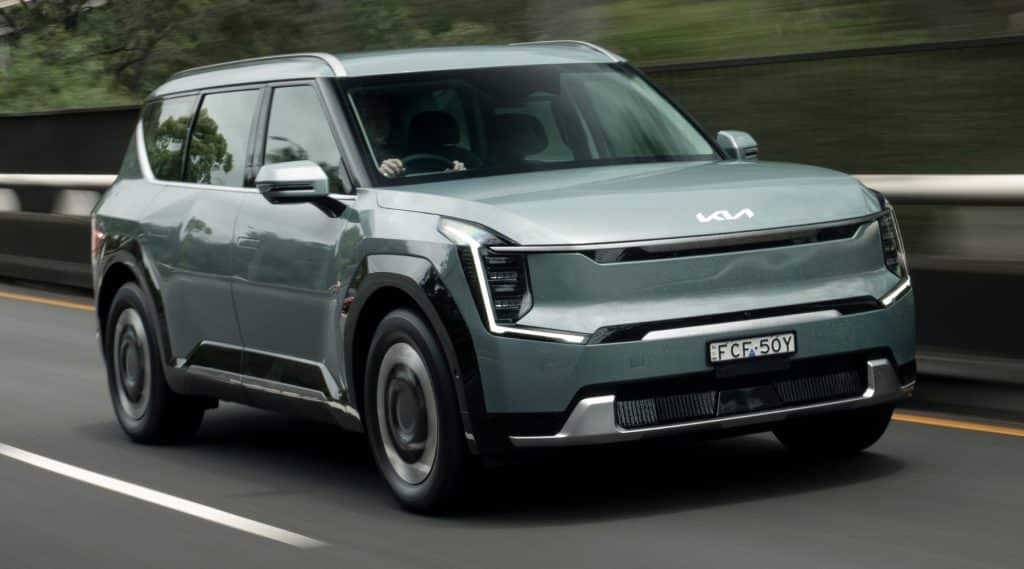
Test Driven: March 26th - April 2nd 2024 - by Adrian Edlington.
"Kia's EV9 SUV is something different - a genuine luxury 7-seater electric vehicle by a non-lux marque that will, in my opinion, compete with the likes of BMW, Mercedes-Benz and Land Rover.
The pimped-out version I was lucky enough to drive has a price point of $139,000, so they sure ain't cheap! On the upside, you get everything you would expect from an SUV of this price. The interior is immaculate and the rear back three seats are equally comfortable. A family of five would fit fine.
The exterior design is a matter of personal taste. While I quite liked it, my female friend was scathing.
In terms of performance, I found the EV9 accelerated fine in Eco mode, which is a big plus. Often, big vehicles like these would be sluggish when trying to be economical.
If you're looking for a luxury SUV, don't exclude the EV9 just because it's a Kia. You could be pleasantly surprised."
- Minimum and maximum price: from $97,000 to $121,000
- Battery capacity: 76.1kWh to 99.8kWh
- Maximum power: 282.6kW/700Nm
- DC ultra-fast charge time (10% to 80%, 350kW): approx. minimum 20 mins
- Range: up to 512km (EV9 Earth)
With the EV6 holding down the crossover SUV position for Kia, the EV9 plays a different role as a large, seven-seat SUV. Like the EV6, it boasts a sleek, futuristic design, but can ferry around large families and your kids’ friends, too.
The price could be a sticking point for many buyers, though, with a steep $97,000 entry for the base Air model and reaching $121,000 as the starting price for the GT-Line (the Earth falls in between with a cost from $106,500). It’s the most expensive Kia sold on our shores so far.
The first big tick for the EV9 is its size, with acres of space in the cabin for you and your passengers. This means that if you’re driving your kids around, there should be enough space to avoid them sitting on top of one another (and creating more fights in the process).
It also comes with an impressive range on the AWDs, with up to 512km on the Earth and 505km on the GT-Line, while the 443km on the base model is nothing to sneeze at. Some of the key safety features are:
- Reverse, Side and Forward Parking Collision Avoidance Assist (PCA)
- Driver Attention Warning System (DAWS)
- Intelligent Speed Limit Assist (ISLA)
As one of the largest options among solely electric models, the EV9 could be a top candidate for families who have the cash to pay for it.
7. Volvo EX40

- Minimum and maximum price: from $76,990 to $82,990
- Battery capacity: 82kWh
- Maximum power: 300kW/670Nm
- DC ultra-fast charge time (10% to 80%, 175kW): approx. minimum 28 mins
- Range: up to 485km (RWD and AWD variants)
Volvo’s XC40 Recharge is now the EX40, with the new name having been unveiled in November last year. It was the Swedish carmaker’s second-most popular EV in 2024, having been outsold by its smaller SUV sibling in the EX30. It finds itself in a similar price category to the Ioniq 5, sitting at a starting price of $76,990 for the Single Motor Extended Range and $81,990 for the Twin Motor.
With a striking angular exterior, the EX40 boasts a futuristic design which is sure to turn heads. In terms of its performance, the biggest plus from a revhead’s point of view is the 300kW of power and 670Nm of torque. It certainly packs a punch in that department.
Outside of that, though, you can enjoy a suite of handy features, including a 9-inch Centre Display, 12.3-inch driver display, wireless charging and a Harmon Kardon Premium Sound system. Safety support systems include:
- BLIS and Cross Traffic Alert
- Lane Keeping Aid
- Oncoming Lane Mitigation
If you’re on the hunt for a powerful small SUV and have a bit more money available, the XC40 Recharge is bound to deliver a thrilling ride.
8. Chery E5

- Minimum and maximum price: from $36,990 to $40,990
- Battery capacity: 61.1kWh
- Maximum power: 150kW/340Nm
- DC fast charge time (30% to 80% at 80kW): approx. minimum 28 mins
- Range: up to 430km (all variants)
The vehicle formerly known as the Chery Omoda E5 is now simply the Chery E5 and currently holds the title of cheapest electric SUV in Australia today. Starting from just $36,990, it rivals the cheapest electric hatches on the market. The Chinese carmaker’s only fully electric model in Australia, the compact E5 sports a striking appearance that is sure to turn heads on the road.
The two E5 variants available in 2025, the Urban (from $36,990) and the Ultimate (from $40,990), are the same in terms of overall performance and safety. Both offer a respectable maximum range of up to 430km and, as a front-wheel drive (FWD), deliver up to 150kW in power and 340Nm of torque. Some of its key safety features include:
- Traffic Jam Assist (TJA)
- Rear Cross Traffic Alert (RCTA) and Rear Cross Traffic Braking (RCTB)
- Speed Limit Information Function (SLIF)
You’ll also enjoy a dual 12.3-inch LCD instrument cluster and integrated multimedia touchscreen, wireless device charging and both Wired and Wireless Apple CarPlay and Android Auto. For the higher spec Ultimate, however, you can enjoy additions such as heated front and outboard rear seats, premium heated steering wheel and eight-speaker Sony sound system (compared to a six-speaker standard sound system).
If you’re looking for a cheap, compact SUV in the electric market, the Chery E5 will set you back the least and deliver an impressive experience.
9. BYD Atto 3
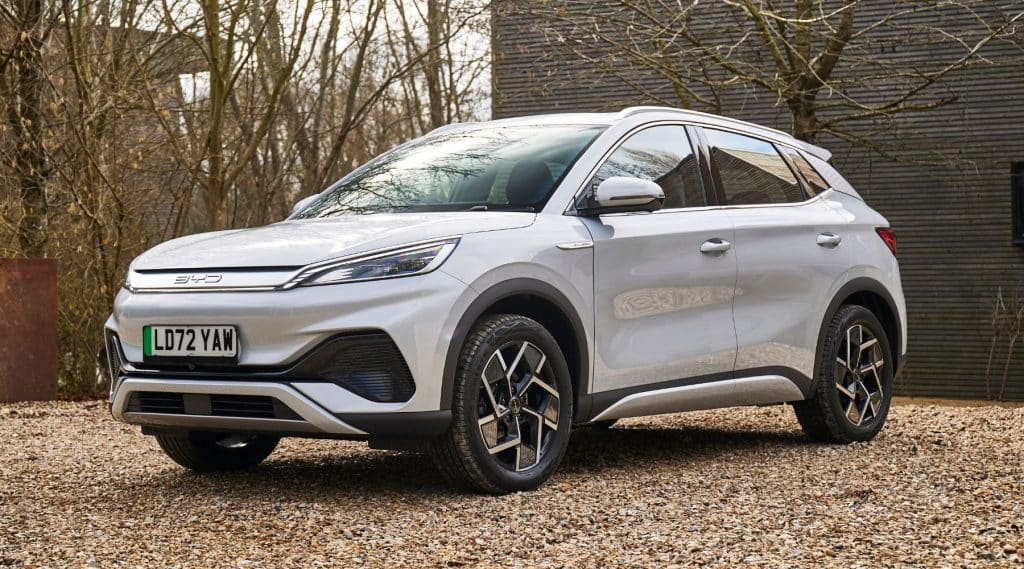
- Minimum and maximum price: from $39,990 to $44,990
- Battery capacity: 49.9kWh to 60.5kWh
- Maximum power: 150kW/310Nm
- Range: up to 420km (Atto 3 Premium Extended Range)
BYD is another Chinese manufacturer that has entered the Australian market with a mid-sized electric SUV. The Atto 3 has proven to be very popular in Australia, with its competitive starting price making it the third best-selling EV in the country in 2023 (11,042) and fifth in 2024 (5,751).
You can choose between two trims: the base Essential Standard Range, coming in at a starting price of $39,990 with a range of up to 345km, and the Premium Extended Range, available from $44,990 and offering an extra 75km of range. The price of the Extended Range places it ahead of several key competitors, such as the Nissan Leaf e+ but behind the ZS EV Long Range.
Both variants come with a suite of safety and convenience features, including:
- 360° view monitor
- 12.8-inch (Essential) or 15.6-inch (Premium) intelligent rotating touch screen
- Voice assistant
- Eight-speaker Dirac HD sound system
At a highly competitive price, the Atto 3 gives you plenty to think about if you’re shopping for an electrified SUV at an affordable price.
Electric hatches
1. MG MG4
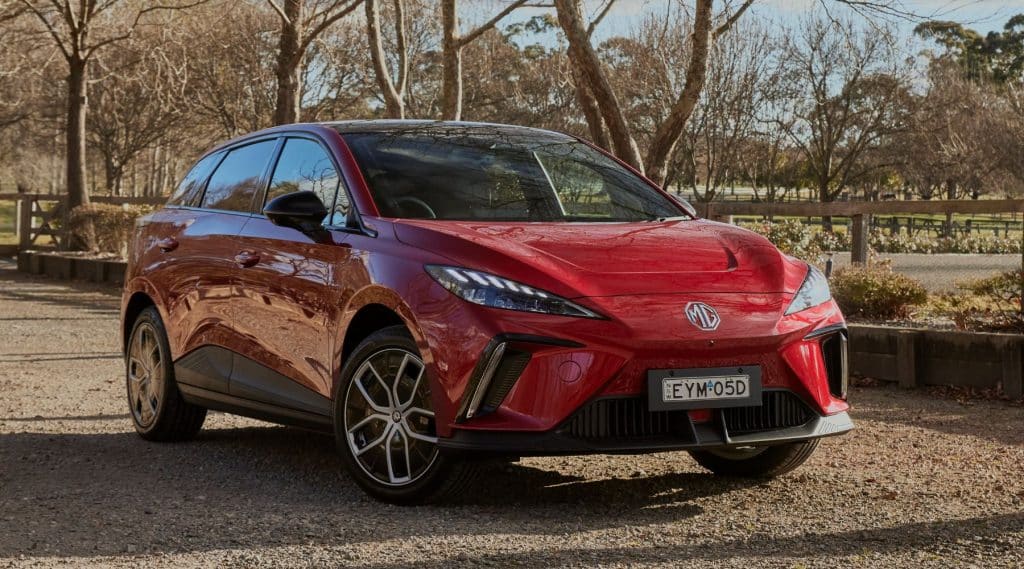
- Minimum and maximum price: from $37,990 to $50,990
- Battery capacity: 51kWh to 77kWh
- Maximum power: 180kW/350Nm
- DC ultra-fast charge time (10% to 80%, 150kW): approx. minimum 28 mins
- Range: up to 530km (MG4 Long Range 77)
The cheapest EV available through MG is the MG4, whose starting price of under $40,000 places it among the most affordable models on the market. This hatchback offers an impressive package for its price, giving you plenty to think about if you’re shopping in the budget EV space.
It’s proven to be popular among the Australian market, as it ended 2024 as the third best-selling EV (6,934). Only Tesla models (Model Y and Model 3) outsold the MG4 across the year.
There are four main variants currently available for the MG4, with each of their names referring to the battery capacity. There’s the Excite 51 (from $37,990), the Excite 64 (from $41,990), the Essence 64 (from $44,990) and the Long Range 77 (from $50,990). However, you could also plump for the MG4 X Power (from $55,990), which, true to its name, offers a more powerful performance at up to 320kW and 600Nm of torque.
Like the MGS5, all models are equipped with MG Pilot, with the full suite of inclusions available for the Essence 64 and Long Range 77. Some of features available across all variants include:
- Unsteady Driving Warning
- Intelligent Headlamp Control
With tight handling and several additional features, including a 10.25-inch Multi-function Colour Touch Screen, Apple CarPlay and Android Auto (both wired only), the MG4 packs plenty of punch for its price point.
2. Hyundai Inster

- Minimum and maximum price: from $39,000 to $45,000
- Battery capacity: 42kWh to 49kWh
- Maximum power: 84.5kW/147Nm
- DC fast charge time (10% to 80%, 120kW): approx. minimum 30 mins
- Range: up to 360km (Inster Extended Range and Cross w/ Sunroof)
Hyundai have dipped their toes in the water of tiny electric cars with the release of the Inster. Nominally a small or even micro-SUV, it fits more comfortably into the hatch category due to its power and (sheer lack of) size for the purposes of our list.
You can choose between the Inster Standard Range (from $39,000 with 42kWh battery), Extended Range (from $42,000 with 49kWh battery) and Cross (from $45,000 with 49kWh battery). The Extended Range and Cross (with sunroof included) are the two models listed as capable of achieving the 360km range, with the addition of a roof basket trimming the Cross’ potential range to 293km.
As is standard across Hyundai’s stable of EVs, you can take advantage of SmartSense’s active safety features, which include:
- Forward Collision-Avoidance Assist (FCA 1.5) including Car/Powered two-wheeler/Pedestrian/Cyclist detection, Direct Oncoming Function, Lane-Change Oncoming/Side functions and Junction Turning functions
- Highway Driving Assist
- Surround View Monitor (SVM) with 3D Surround View function (Cross only)
With its battery capacity of up to 49kWh and power maxing out at just 84kW and 147Nm of torque, it’s safe to say you aren’t buying the Inster for its brute force on the roads. What it does offer is a clean, compact set of wheels designed for city living.
There’s no doubt that the Inster has plenty to offer prospective drivers. However, the question you’ll ultimately have to ask yourself is whether it’s worth the additional investment compared to some of the other budget hatches on this list.
3. All-Electric Mini Cooper
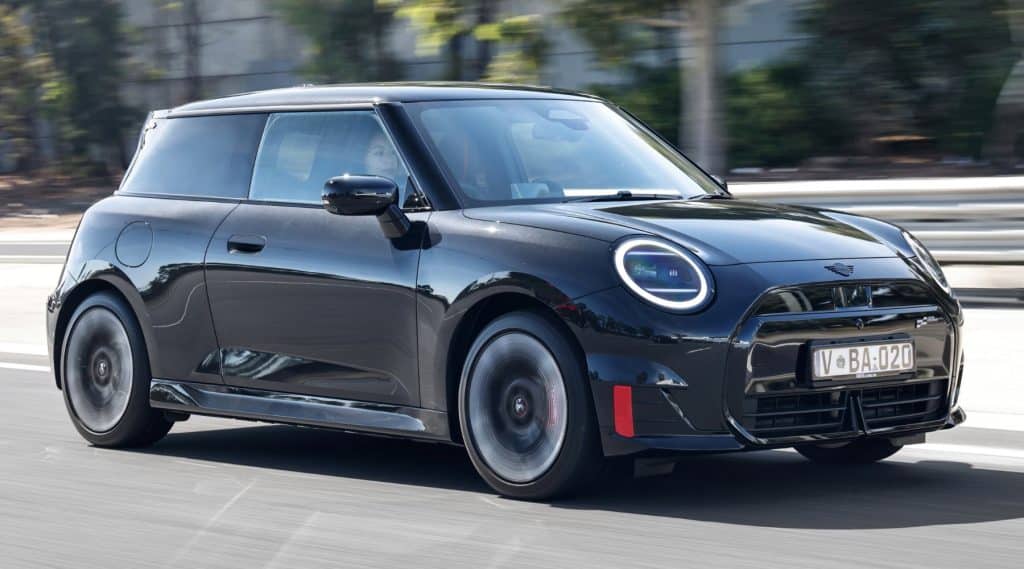
- Minimum and maximum price: from $53,990 to $63,990
- Battery capacity: 41kWh to 54kWh
- Maximum power: 190kW/350Nm
- DC fast charge time (10% to 80%): approx. minimum 28 mins
- Range: up to 402km (Cooper SE)
When it comes to prestige names in the hatchback space, few carry as much weight as the Mini Cooper. The iconic British model now has a fully electric suite of variants, known as the All-Electric Mini Cooper range. Notably, the EV version of the Cooper is built on a skeleton co-created by BMW and GWM, rather than solely relying on BMW construction as the petrol models do.
The Cooper E is the base model, with the $53,990 starting price a step up from the more budget-friendly hatches we’ve spoken about so far. The SE (from $58,990) is the next rung up, with the highest-performance model being the JCW (from $63,990).
The Cooper is the smallest of the models we’ve discussed so far, having only four seats and three doors. However, as Minis are known to do, it aims to cram plenty of fun into a small package when it comes to the driving experience. The “Go Kart” driving mode, alongside six others you can choose from, and Panorama Glass Roof speak for themselves.
Some of the standard infotainment features across the range include Mini’s Augmented Reality Navigation, Intelligent Personal Assistant (IPA), Wireless Apple CarPlay and Android Auto and a Harmon/Kardon Surround Sound System (not included on the Cooper E). You can also take advantage of safety technologies like:
- Attentiveness Assistant
- Intelligent Emergency Call
- Vehicle Exit Warning
While it may not offer the same power as other EVs on the market, there’s no doubt that you’ll get a kick out of driving the All-Electric Mini Cooper. You’re paying a premium, but you’re getting a strong brand identity and fun experience to go along with it.
4. Abarth 500e
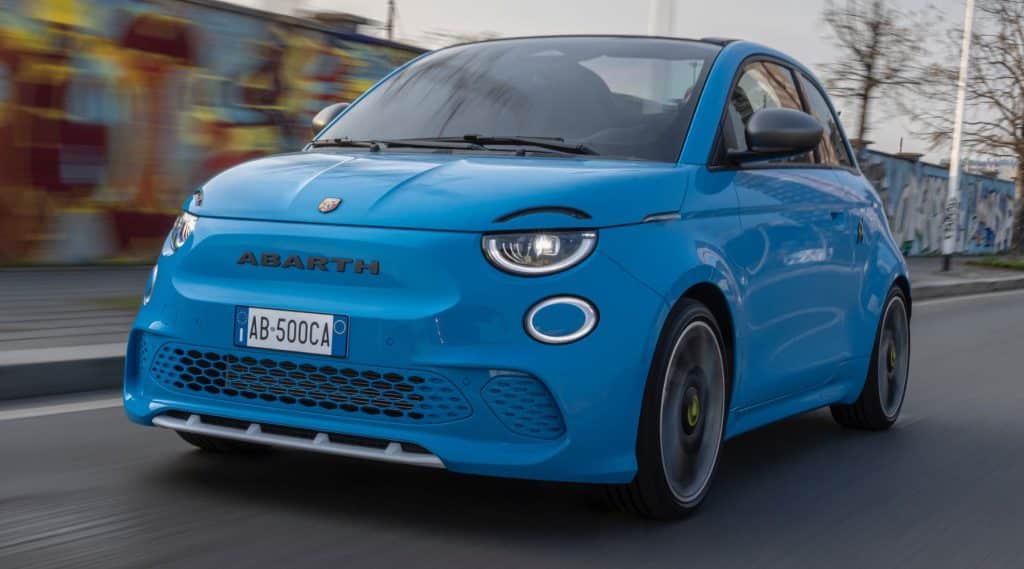
- Minimum and maximum price: from $58,900 to $60,500
- Battery capacity: 42kWh
- Maximum power: 113kW/235Nm
- DC fast charge time (0% to 80%, 85kW): approx. minimum 35 mins
- Range: up to 253km (all variants)
Another up-market three-door hatch, the Abarth 500e is a higher-power, performance-focused version of the Fiat 500e. These models share the same electric platform and are both operated by multinational automaker Stellantis, who also own Chrysler, Alfa Romeo, Jeep, Peugeot, Citroën and more.
In Australia, you’re likely to only have the option of the Turismo (from $58,900), as only 219 units of the launch-exclusive Scorpionissima (from $60,500) were available across the country.
Although it’s more performance-oriented than Fiat’s namesake model, the maximum power (113kW), torque (235Nm) and range (253km) is the lowest of any car on this list. However, the car’s lightweight build allows it to still deliver on the zip that you’re looking for with a car adorned with that famous name.
The safety features aren’t jam-packed on the 500e, but include:
- Traffic Sign Recognition and Intelligent Speed Control
- Front, Side and Rear Parking Sensors
- Driver Behaviour Warning
It’s worth noting that the Abarth 500e is unrated by ANCAP, while the Fiat 500e currently holds a four-star rating. Like the electrified Cooper, though, its greatest appeal is the fun it provides you when you’re at the wheel. A 10.25-inch infotainment touchscreen, JBL sound system and even a sound generator that mimics the noise of a starting and revving petrol Abarth help cement that.
5. BYD Dolphin
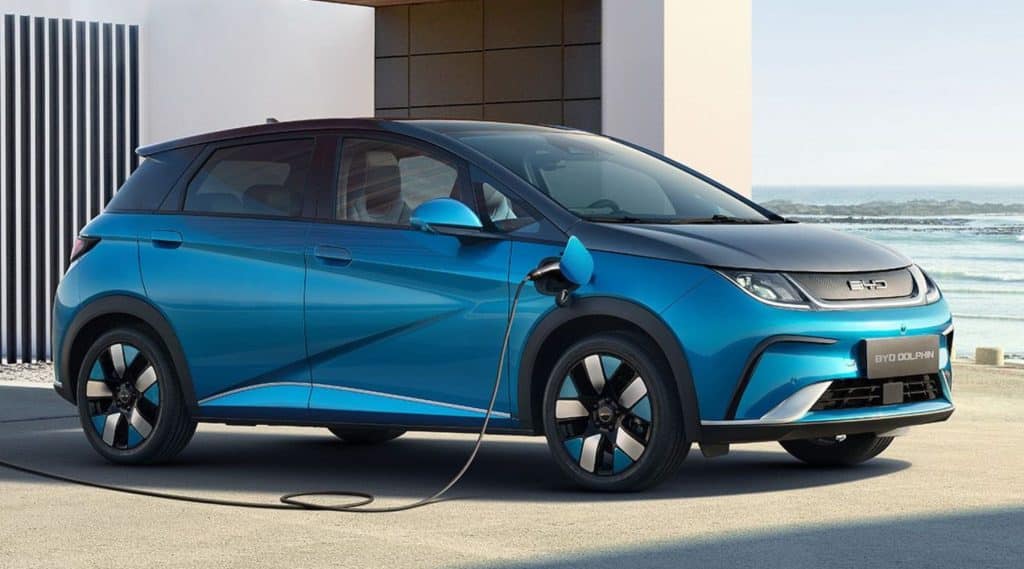
- Minimum and maximum price: from $29,990 to $36,990
- Battery capacity: 44.9kWh to 60.5kWh
- Maximum power: 150kW/310Nm
- Range: up to 427km (Dolphin Premium)
The Dolphin from BYD currently holds the title as the cheapest non-commercial electric vehicle in Australia, coming in at a cool starting price of just $29,990 for its base Essential model and $36,990 for the Premium variant. It was this pricing that helped the Dolphin make a splash and land in the top ten best-selling EVs across Australia in 2024.
The Essential doesn’t come with very much power at all, with its 44.9kWh battery capable of outputs of only 70kW and 180Nm of torque. However, the Premium more than doubles this, with its 60.5kWh battery able to produce up to 150kW and 310Nm of torque, as well as an improved range of 427km compared to 340km.
Despite the basement price tag, the Dolphin still comes with a range of useful safety features, including:
- 360° view monitor
- Bluetooth key and BYD digital key
- Traffic Sign Recognition (TSR)
6. GWM Ora
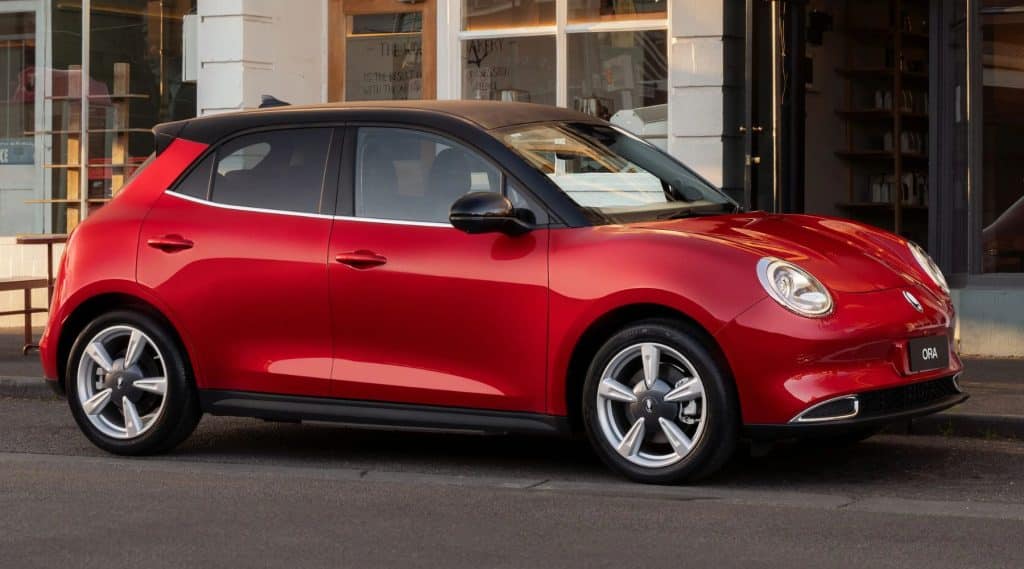
- Minimum and maximum price: from $34,490 to $46,990
- Battery capacity: 48kWh to 63kWh
- Maximum power: 126kW/250Nm
- DC fast charge time (10% to 80%, 80kW): approx. minimum 41 mins
- Range: up to 420km (GWM Ora Extended Range)
Coming in at just under the MG4’s starting price is the GWM Ora, another affordable Chinese-manufactured hatch for Australian budget shoppers to consider. The Ora Standard Range begins at just $35,990, with the Extended Range clocking a starting price of $40,990.
In terms of its design, the Ora undoubtedly shares some key elements with some world-famous hatchbacks, with its exterior not looking entirely out of place among a Beetle or Mini Cooper lineup.
With an instrument cluster and a colour infotainment touchscreen both measuring 10.25 inches, as well as Apple CarPlay (but not Android Auto) and Bluetooth connectivity, the Ora isn’t jam-packed with entertainment features. It does come with a range of safety technologies across both variants, including the following:
- 360 Degree Monitoring System
- Driver Drowsiness Detection
- Traffic Sign Recognition (TSR)
All up, the Ora from GWM presents a competitive package for an all-electric vehicle on a budget and could be a great choice for comfortable city driving.
Electric sedans
1. Polestar 2

Test Driven: 15-19th December 2022 - by Adrian Edlington.
"I drove the top-spec 2023 Polestar 2 for 5 days both in the city and on a road trip around the Fleurieu Peninsula and loved every minute of it!
The handling, pick-up and performance were truly amazing. This thing accelerates so fast I'd have to warn passengers to have their heads against the headrest and look forward, lest they put their necks out! It was almost TOO quick. Travelling along winding roads in the powerful sedan left one passenger with a bout of car sickness, albeit while the driver was having a blast.
After a day or two of driving like a hoon, I was able to calm down a bit and rely on the adaptive cruise control - the best way to avoid a speeding ticket in both urban areas and on the open road.
My one and only criticism of the Polestar 2 is that the optional extras come in non-negotiable packs, so if you want the epic Harman Kardon 13-speaker sound system, you'll need to fork out for the moon roof. Also, the back seats weren't so comfy, so my passengers told me, though who cares? They would be fine for short trips, kids or baby seats.
Another plus is that the price seems to have come down since I first reviewed the Polestar2 in 2022. In my state of South Australia, the Long range Dual motor with Performance pack goes for $89,339.72.
- Minimum and maximum price: from $64,900 to $86,780
- Battery capacity: 69kWh to 82kWh
- Maximum power: 350kW/740Nm
- DC ultra-fast charge time (10% to 80%, 205kW): approx. minimum 28 mins
- Range: up to 659km (Polestar 2 Long Range Single Motor)
The Polestar 2 starts to move into luxury car territory, although at a starting price of $64,900 remains in the mix with the Model 3 and Ioniq 6. This is available for the Standard Range Single Motor, with the Long Range Single Motor (from $68,900) and Long Range Dual Motor (from $73,900) also available.
You’ll have a series of packs to choose from as well, with the Pilot Pack (now standard on all Polestar 2 variants), Plus Pack, Performance Pack, Pro Pack and Climate Pack all bringing a range of additional features to the party. However, with the top-level Long Range Dual Motor costing just under $13,000 more with the Plus and Performance Packs, it’s important to work out whether it’s worth the investment.
The handling on the Polestar 2 is one of its key attributes, alongside its streamlined European design. The RWD variants alone are capable of up to 220kW of power and 490Nm of torque, providing impressive acceleration. However, the AWD variants kicks it up a notch, reaching a peak of 350kW and 740Nm with the Long Range Dual Motor with Performance Pack.
Some of the standard features include:
- 12.3-inch driver display area and 11.2-inch centre display area
- 13-speaker Harmon Kardon Premium Sound system (Dual Motor variants only)
- Memory function with up to six driver profiles
If you have the budget, the Polestar 2 is sure to give you an entertaining yet comfortable ride.
2. Tesla Model 3
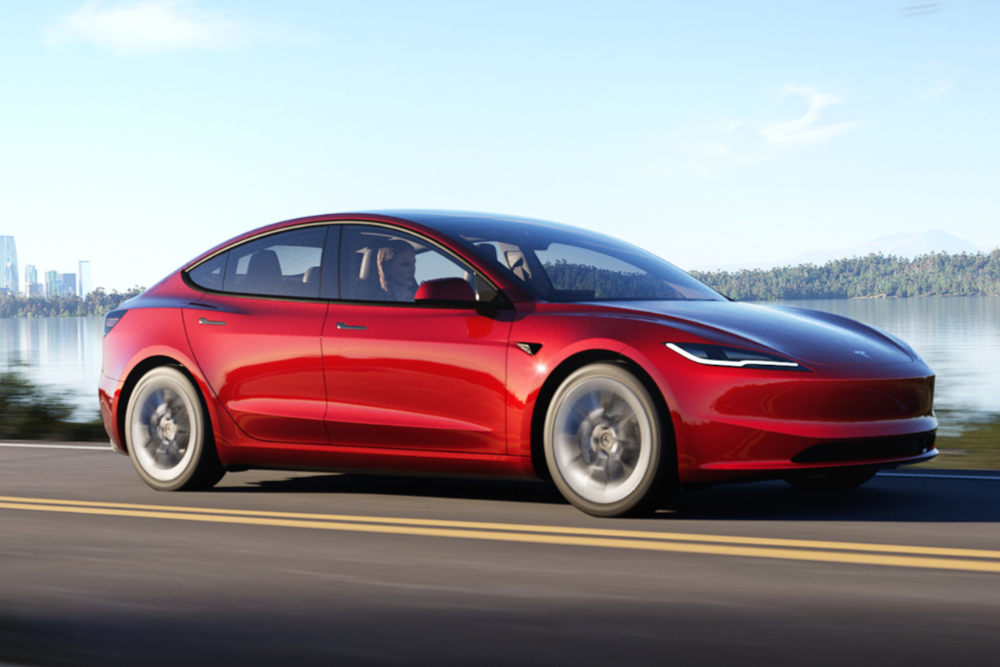
- Minimum and maximum price: from $54,900 to $80,900
- Range: up to 629km (Model 3 Long Range)
The second of Tesla’s vehicles currently available on the Australian market, the Model 3 finished only behind the Model Y in terms of sales in 2024 (17,094), proving to be extremely popular in an ever-growing market. It finds itself on the cheaper end of the scale for vehicles of this make, with the base Rear-Wheel Drive model having dropped its starting price to $54,900 from $61,900 and the Long Range AWD cutting it to $64,900 from $71,900. The Performance model remains at a starting price of $80,900.
As is the case with the Model Y, figures such as power output, torque and charging times aren’t readily available, but you can rest assured the Model 3 delivers on speed. Indeed, it claims that the Long Range, which can travel up to a highly impressive 629km per charge, can accelerate from 0 to 100km/h in just 4.4 seconds.
It also offers plenty in the way of technological innovation, from accessing, unlocking and turning on the A/C with your phone before entering the vehicle to a 15-inch centre touchscreen, 8-inch rear touchscreen and much more. Despite often courting controversy through its outspoken CEO, Elon Musk, Tesla’s cheapest model is still one of the most sought-after sedans in Australia.
3. Hyundai Ioniq 6
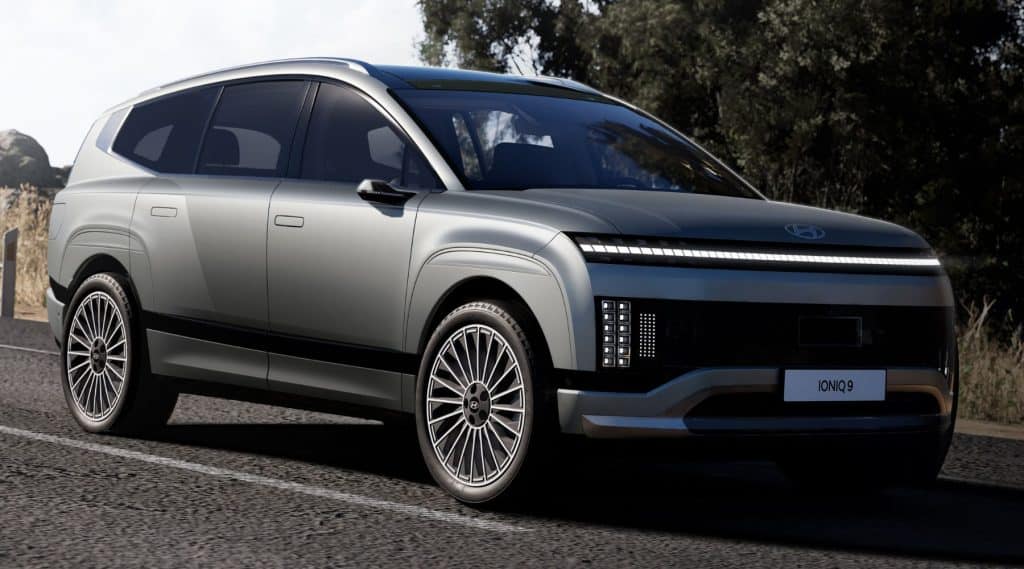
Test Driven: 10-19th July 2023 - by Adrian Edlington.
"I test-drove the Hyundai IONIQ 6 Techniq for nine days in Winter 2023. Fair to say I didn't like the look of it at first glance, though it really grew on me.
The IONIQ 6 is designed as an EV from the ground up, so it benefits from the freedom to do things differently. The front of the car seems quite short, while the boot is HUGE. It's really quite deceptive, though in a good way. Since there's no need to allow for an engine in the front, it saves on space and allows for more room in the cabin. The legroom in all four seats is spacious, which is a real plus.
The IONIQ's interior includes many features from their lux brand Genesis, so you feel like you're getting a lot of design bang for your buck.
Hyundai have really done a great job with this car and they seem priced right. I'd recommend taking one for a test drive and seeing for yourself."
- Minimum and maximum price: from $66,500 to $89,500
- Battery capacity: 77.4kWh
- Maximum power: 239kW/605Nm
- DC ultra-fast charge time (10% to 80%, 350kW): approx. minimum 18 mins
- Range: up to 614km (Ioniq 6 Dynamiq)
Sleek is perhaps the best word to describe the Ioniq 6 from Hyundai. The electric sedan adopts a curve-focused exterior, with all the soft lines along the side and top of the car meeting in a futuristic light cluster at the back.
Like the Ioniq 5, the Ioniq 6 is equipped with Hyundai SmartSense, giving it a wide range of features designed to make your ride a safer one. However, it also comes with its Bluelink connected car service, which comes with functions such as:
- Automatic Collision Notification (ACN)
- Voice Control – server-based & natural voice recognition, including vehicle controls, information, command & control
- Valet Mode function – restricted infotainment control
- Calendar integration (Google, iCloud) – weather forecast information & vehicle diagnostics
The range available with the Ioniq 6 can reach up to 614km on a single charge with the Dynamiq, with the Tehcniq and Epiq offering ranges of up to 519km, which beats out its closest rival in terms of build and price, the Model 3 (513km on the Rear-Wheel Drive). If you’re looking for a comfortable drive with a luxurious and spacious interior, look no further.
4. BYD Seal

- Minimum and maximum price: from $46,990 to $61,990
- Battery capacity: 61.4kWh to 82.6kWh
- Maximum power: 390kW/670Nm
- Range: up to 570km (Seal Premium)
BYD’s Seal is its first foray into the sedan segment. As is the case with most of the Chinese manufacturer’s other models, the Seal is currently the cheapest electric sedan in Australia, starting from $49,888 for the Dynamic, $58,798 for the Premium and $68,798 for the Performance.
The Dynamic and Premium are both RWDs, with the former packing a 61.4kWh battery and the latter an 82.6kWh one. However, the Performance is an AWD, with the same 82.6kWh battery allowing it to reach up to 390kW of power and 670Nm of torque compared to the Premium (up to 230kW and 360Nm).
BYD states that the Premium is capable of reaching up to 650km on a single charge, but this measurement is based on the New European Driving Cycle (NEDC) system. To achieve a more accurate comparison between vehicles, the testing method we’re using is the industry-preferred World harmonised Light vehicle Testing Procedure (WLTP), which places it at a much lower (but still very impressive) 570km.
Packing several key safety features, such as Traffic Sign Recognition (TSR), Emergency Lane Keeping Assist (ELKA), Head Up Display (W-HUD), and an improved 15.6-inch intelligent Rotating touch screen display and 12-speaker DYNAUDIO sound system, this could be a good option if you’re looking to pay a bit less for your EV sedan.
5. BMW i4
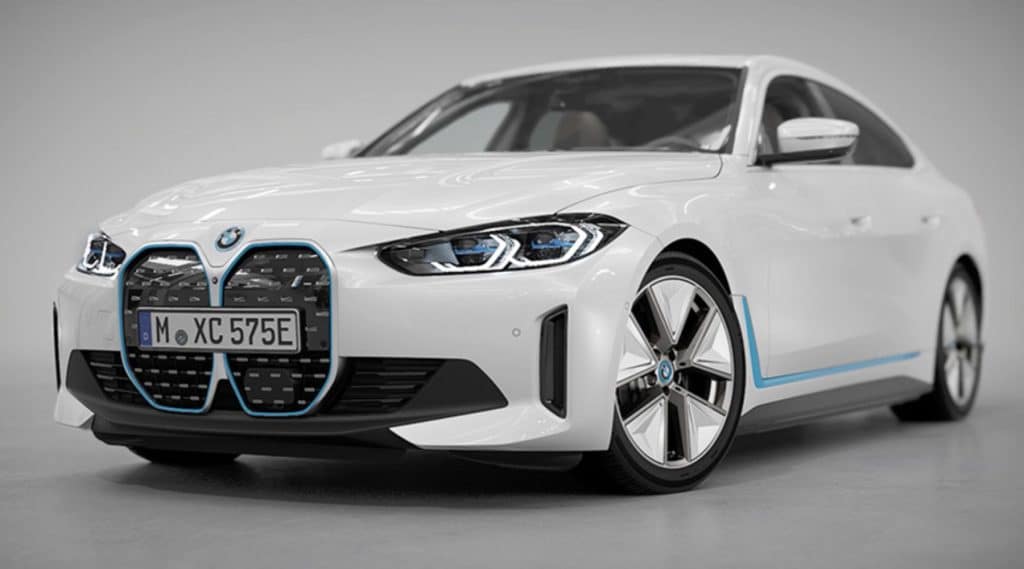
- Minimum and maximum price: from $85,900 to $133,900
- Battery capacity: 70kWh to 84kWh
- Maximum power: 400kW/795Nm
- DC ultra-fast charge time (10% to 80%, 190kW): approx. minimum 31 mins
- Range: up to 520km (i4 eDrive40)
The introduction of a cheaper base model brings the entry point for the BMW i4 down to under $90,000, which is highly competitive for a luxury electric sedan with that kind of nearly unrivalled name recognition.
The new base RWD model, the eDrive35, offers up to 210kW of power, 400Nm of torque and 430km of range, which is bettered by the eDrive40 (from $102,900) with 250kW, 430Nm and 520km, respectively. The top-line M50 (from $133,900) kicks it up a gear with a ridiculous 400kW of power and 795Nm of torque, though the AWD’s range falls to 465km.
The blue accents on the exterior are particularly striking, accentuating the aerodynamic design of the car. In terms of features, all models come with a BMW Live cockpit Professional display, which incorporates the 12.3-inch instrument cluster and 14.0-inch control display into a single unit, as well as a host of safety technologies like:
- BMW Head-Up Display
- Driving Assistant Professional
- Parking Assistant Plus (including Parking Assistant with Active Park Distance Control front & rear, Reversing Assistant, Surround View, Panorama View and 3D View
While the i4 makes a great case for a powerful luxury EV under $100,000, it’s worth noting that ANCAP rated the model four stars in 2022, giving it 71% for Vulnerable Road User Protection and 62% for Safety Assist. The i4 will hold this rating until 2028.
Electric utes
1. LDV eT60
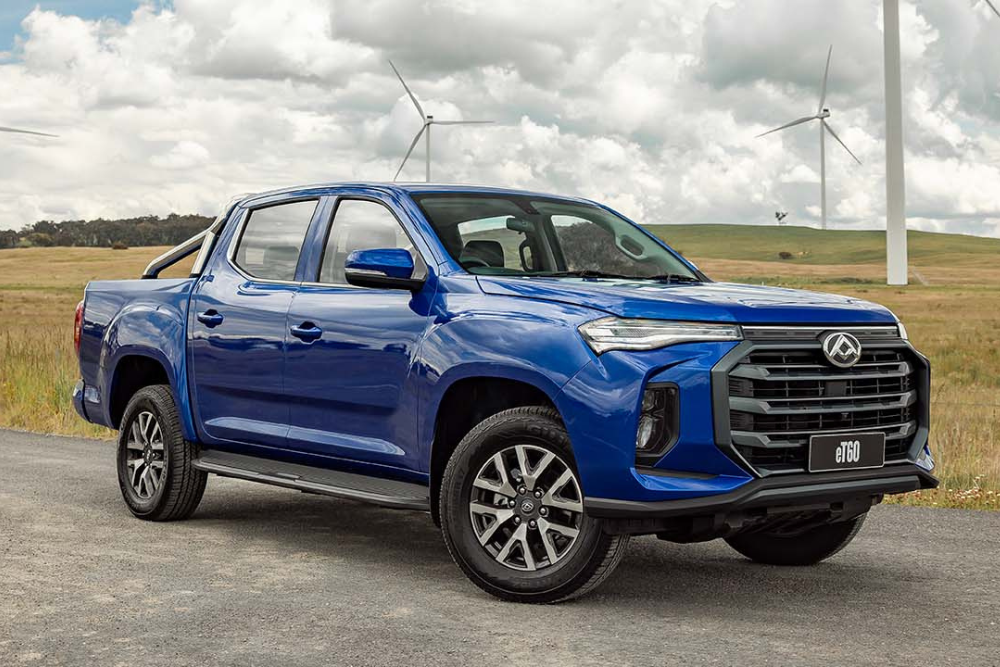
- Minimum and maximum price: from $92,990
- Battery capacity: 88.6kWh
- Maximum power: 130kW/310Nm
- DC fast charge time (20% to 80%, 80kW): approx. minimum 45 mins
- Payload: up to 1,000kg
- Braked towing capacity: up to 1,000kg
- Range: up to 330km
The eT60 from LDV is the first and, as of July 2025, only electric ute to go on sale in Australia through its own manufacturer. It isn’t necessarily immediately approachable with a starting price as high as $92,990, which doesn’t include on-road costs, but the eT60 is the first of many of its kind on our roads over the next five to ten years.
With an 88.6kWh battery and as a 2WD, the eT60 can reach outputs of up to 130kW of power and 310Nm of torque, as well as a more limited potential range of up to 330km. It also only offers a 1,000kg towing capacity, which is far below some of the leading utes on the market (the Ford Ranger and Toyota HiLux pack hulking towing capacities of up to 3,500kg).
It hasn’t been easy going for the eT60, being panned by automotive reviewers and having registered paltry sales figures since it was introduced in Australia. However, with the 4WD eTerron 9’s release fast approaching, LDV will be hoping that it’s able to shift more units than it did with the eT60.
2. Ford F-150 Lightning

- Minimum and maximum price: from $169,900 to $184,900
- Battery capacity: 98kWh to 131kWh
- Maximum power: 433kW/1,050Nm
- DC fast charge time (15% to 80%): approx. minimum 32 mins
- Payload: up to 1,000kg
- Towing capacity: up to 4,500kg (F-150 Lightning Extended Range)
- Range: up to 515km (F-150 Lightning Extended Range)
The F-150 Lightning is also now available in Australia, albeit in a more unconventional sense. Ford showrooms aren’t displaying this model, nor is it being manufactured in right-hand drive. Rather, Australian vehicle distribution company AusEV is selling the converted right-hand drive vehicles without any involvement from Ford showrooms.
If you’re interested in one of these utes, though, you’ll have to stump up at least an eye-watering $169,900 for the Standard Range model or an extra $15,000 for the Extended Range variant. Remember: these are before on-road costs.
However, what you’ll get for that hefty investment is a beast of a vehicle, offering a power output of up to 433kW and torque of 1,050Nm. The Extended Range also keeps you on the road for up to 515km, with all of these metrics far outweighing those of the eT60.
Potential future electric ute arrivals
LDV eTerron 9

The new and improved electric ute from LDV, the eTerron 9’s arrival is slated for the second half of 2025. The dual-cab 4WD will improve on the eT60’s power with its 102kWh lithium-ion battery, adding an extra 100km in range and ramping up its towing capacity to 3,500kg. Reaching our shores before the end of the year would likely mean that LDV will have two electric utes on the market before anyone else has one.
Isuzu Ute D-Max EV
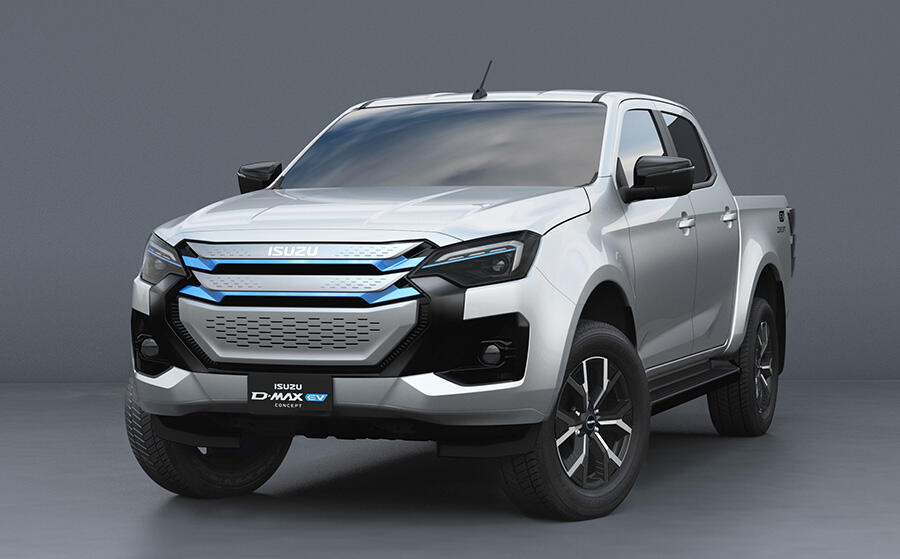
An all-electric version of the popular D-Max from Isuzu Ute is expected to be unveiled in Australia in 2026 (with dates yet to be confirmed). Although its specs haven’t been released, Isuzu Ute has claimed it’ll be a 4WD packing 140kW of power and 325Nm of torque, as well as a payload of up to 1,000kg and towing capacity of 3,500kg.
Kia Tasman EV
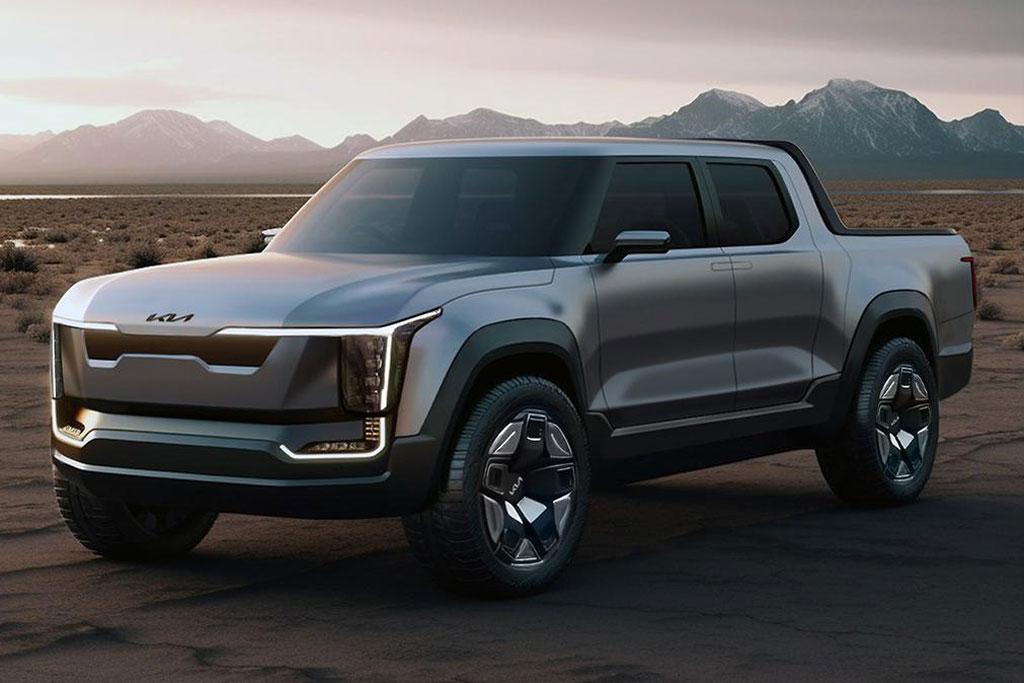
Kia has said they’re working on an electric version of the newly unveiled Tasman ute, which is set for release as soon as 2026.
JAC T9 EV
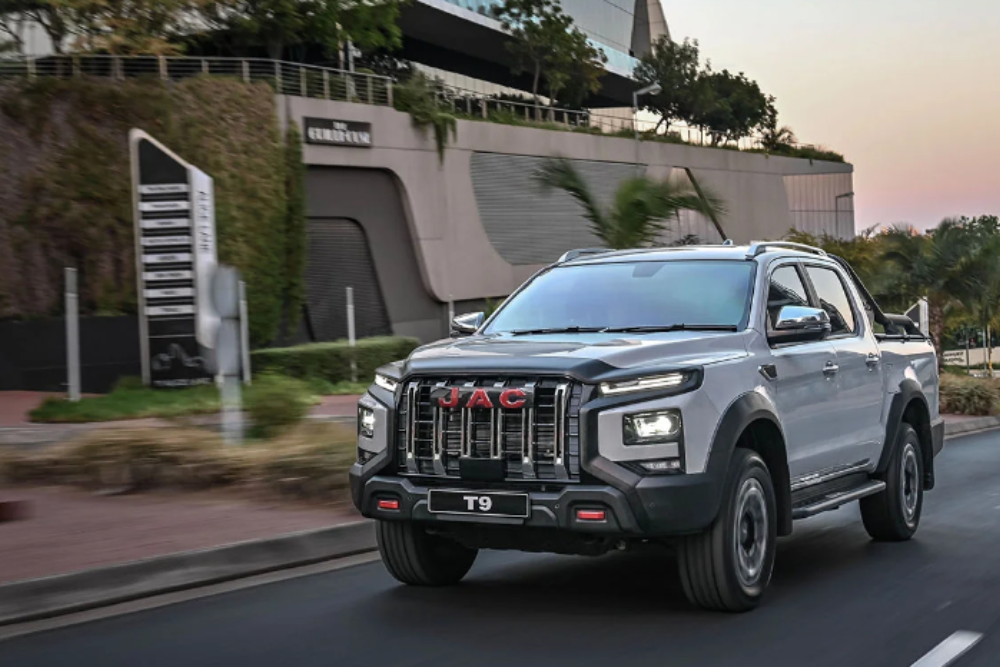
Having released the T9 ute in Australia in 2024, Chinese manufacturer JAC has yet to confirm whether an electric version will reach our shores. However, we know it’ll come with an 88kWh battery and superior power output of 210kW and 516Nm of torque.
Luxury electric vehicles
1. Audi e-tron GT
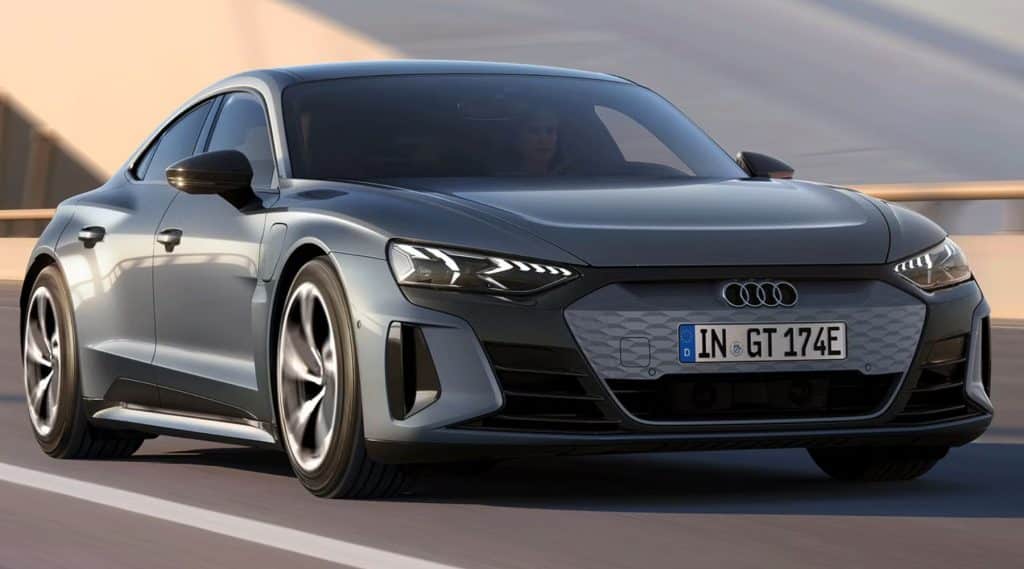
- Minimum and maximum price: from $181,784 to $250,484
- Battery capacity: 93kWh
- Maximum power: 475kW (in boost mode)/830Nm
- DC ultra-fast charge time (5% to 80%, 270kW): approx. minimum 23 mins
The Audi e-tron GT range consists of two models: the e-tron GT and the RS e-tron GT, which start at prices of $181,784 and $250,484, respectively. While it isn’t as powerful as the Taycan (what is?), the e-tron GT can still hit the heights of 350kW (390kW in boost mode) and 630Nm of torque (640Nm in boost mode). Just a reminder: this is the base model.
The RS e-tron GT takes it a step further with up to 440kW (475 in boost mode) and 830Nm. However, just because it’s fast doesn’t mean it isn’t safe, as it comes with the following features:
- Audi pre-sense city with Autonomous Emergency Braking, pedestrian detection and cyclist detection
- Audi active lane assist
- 360-degree cameras including kerb view function
- Park assist with Audi parking system plus including front and rear sensors
- Intersection crossing assist
- Turn assist
Add to these three and six-year complimentary subscriptions to Audi connect plus and Chargefox, respectively, a virtual cockpit with a 12.3-inch colour display, a 16-speaker Bang & Olufsen 3D sound system and the slick German design shining through inside and out, you can drive in luxury. However, Audi doesn’t confirm an exact figure for the e-tron GT’s range.
Back to luxury electric vehicles
2. Genesis Electrified G80
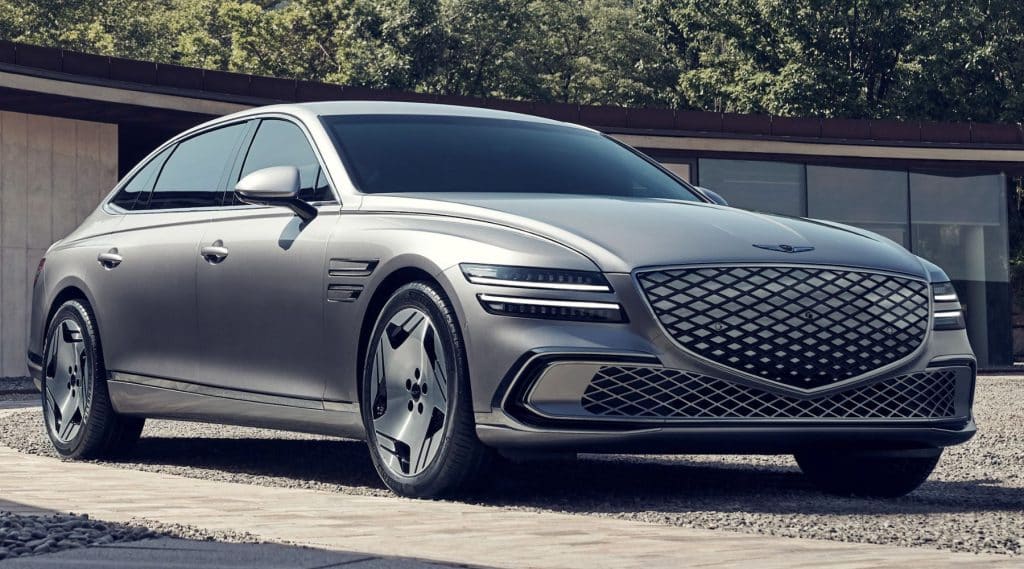
Test Driven: 13-20th February 2023 - by Adrian Edlington.
"The Genesis G80 electric is a luxurious tank of a car that feels better suited to a Hong Kong action film than the streets of Adelaide.
I'm really not sure who the target market in Australia might be, given the price point and dimensions. While the front seats are great, being a passenger in the rear is not enjoyable for anyone 5' 10" and over, owing to the under-floor battery raising the foot well floor. This makes it less appealing in my opinion as a chauffeured fleet vehicle.
The G80 is beautiful, however, and turns heads. It's a lot of fun to drive and handles really well for a car this size. I liked how Genesis included a combo of physical buttons and controls alongside the touch-screen ones. These are more intuitive to use as you get a feel for where they are and don't need to take your eyes off the road as with a touch-screen.
The G80 electric is a conversion from the big-engined fossil fuel models, so seems to waste a lot of space in the front when compared to an EV built from the ground up, such as the GV60.
I can see this model being very popular in Japan and throughout Asia more broadly. You get a big luxury sedan for a fraction of the cost of major competitors. Australian sales definitely won't affect the success of this vehicle, that's for sure."
- Minimum and maximum price: from $155,000
- Battery capacity: 94.5kWh
- Maximum power: 272kW/700Nm
- DC ultra-fast charge time (10% to 80%, 350kW): approx. minimum 22 mins
- Range: up to 520km
The Electrified G80 is the only fully electric model from Genesis’ G80 line of luxury sedans. Unlike the Polestar 2, another luxury electric sedan (albeit much cheaper), the Electrified G80 comes in only one trim level, the Signature, and with all possible extras already included, rather than offering optional packs for an extra outlay.
Its maximum 272kW power output and 700Nm torque ensure you’ll get a bit of zip on the road, while its claimed range of up to 520km is highly competitive, though slightly lower than some of the other sedans mentioned on this page. It also packs in a variety of convenience and safety features for drivers, including:
- Capacitive touch front door handles
- Surround View Monitor (SVM) with 3D Surround View function
- Intelligent Speed Limit Assist
- Blind-Spot Collision Avoidance Assist – Rear/Side (BCA – R/S)
- 14.5-inch capacitive HD touch screen display
- Bang & Olufsen 17-speaker sound system
There’s no doubt the Electrified G80’s opulent interior, generous range and competitive price compared to other players in the luxury market will appeal to plenty of buyers.
Back to luxury electric vehicles
3. Polestar 3
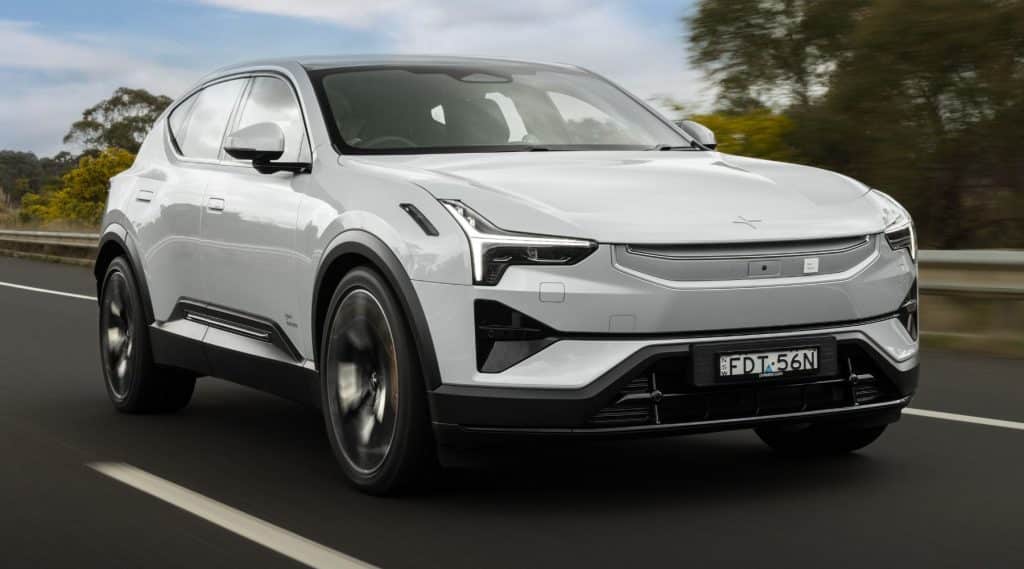
- Minimum and maximum price: from $121,920 to $159,620
- Battery capacity: 111kWh
- Maximum power: 380kW/910Nm
- DC ultra-fast charge time (10% to 80%, 250kW): approx. minimum 30 mins
- Range: up to 706km (Polestar 3 Long Range Dual Motor)
The most expensive model currently on offer from Polestar in Australia, the Polestar 3 combines luxury with powerful performance. It’s expanded its range of variants from solely the initial Long Range Dual Motor to a lower-spec (and cheaper) Long Range Single Motor.
The newer Single Motor variant brings with it an industry-leading 706km in claimed range. This means that, if the conditions were right, you could travel the equivalent of almost the full distance from Melbourne to Adelaide without needing to take a pitstop (though we certainly aren’t advising you to have a crack at this).
Like the Polestar 2, the price will increase if you choose to add an optional pack or packs. It’s worth noting that a Long Range Dual Motor with the Performance, Pilot and Plus Packs would set you back over $26,000 more than the base variant. While it’s capable of reaching 360kW of power and 840Nm of torque as is, the Performance pack elevates it to a maximum of 380kW and a crazy 910Nm.
The display is slightly different to the Polestar 2’s, with a 9-inch driver display and 14.5-inch centre display area. It also boasts a rearview camera with automatic cleaning function, 12 ultrasonic sensors and a range of other safety features as standard, including:
- Blind Spot Information with steer assist
- Corner Traction Control (through torque vectoring)
- Road Sign Information
- Trailer Stability Assist
- Regenerative Stability Control
- Driver Steering Recommendation
It goes without saying that you expect a rewarding driving experience if you’re willing to fork out over $100,000 for an EV. The Polestar 3 is well-placed to deliver just that.
Back to luxury electric vehicles
4. Mercedes-Benz EQE 350 SUV

- Minimum and maximum price: from $146,700
- Battery capacity: 90.6kWh
- DC ultra-fast charge time (10% to 80%, 350kW): approx. minimum 32 mins
Another name synonymous with prestige and luxury, Mercedes-Benz has a range of electric vehicles available for purchase in Australia. The EQE SUV was the second most popular of these in Australia in 2024 (759), behind only the EQA (1,044).
The luxury SUV is an all-wheel drive that offers performance and precision through its 90.6kWh capacity battery. Like Tesla, specifics on power, torque and range are hard to come by through official Mercedes-Benz channels, but they do advertise several advanced safety features:
- Active Lane Keeping Assist
- Active Distance Assist DISTRONIC
- PRE-SAFE Impulse Side
- GUARD 360° vehicle protection
- Traffic Sign Assist
Couple these with some of the comfort and convenience additions like Zero Layer OLED central display, Burmester 3D surround sound system, Parking Package with 360° camera, high-quality trim and upholstery and you have yourself a ride fit for a king.
Back to luxury electric vehicles
5. Porsche Taycan
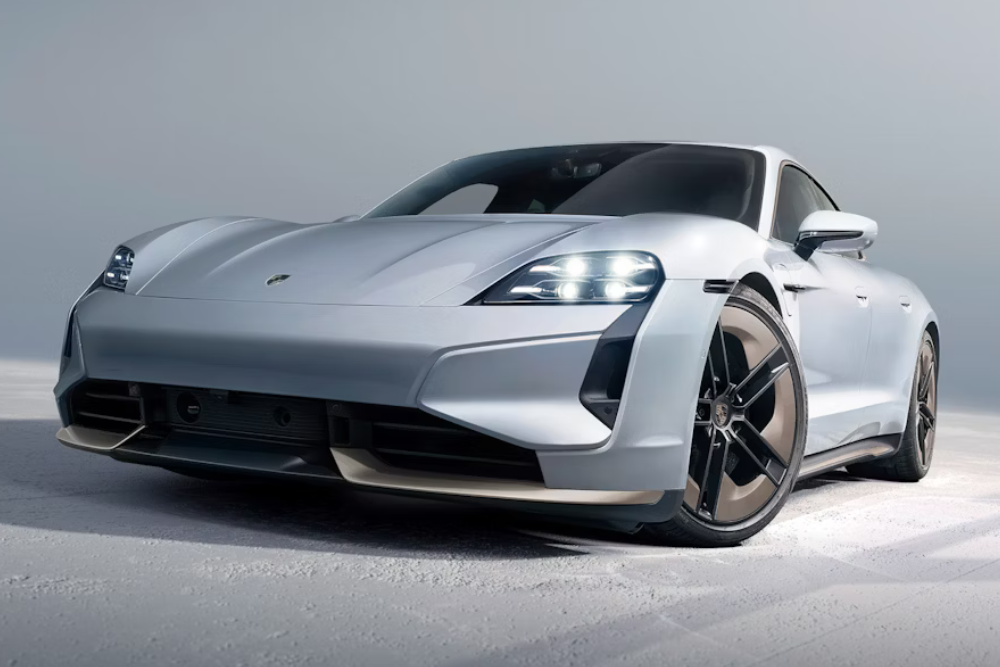
- Minimum and maximum price: from $175,100 to $416,600
- Battery capacity: 82.3kWh to 97.0kWh
- Maximum power: 760kW/1,240Nm (Overboost Power with Launch Control)
- DC ultra-fast charge time (10% to 80%, 320kW): approx. minimum 18 mins
- Range: up to 651km (Taycan with Performance Battery Plus)
The first all-electric car from German manufacturer Porsche is, true to form, a powerful and eye-catching one. It was among the top-selling luxury EVs in Australia in 2023 at over 500 models, but fell away to just 282 in 2024.
There are a massive 11 variants of the Taycan in their 2025 lineup, which are:
- Taycan: from $175,100
- Taycan 4: from $184,500
- Taycan 4 Cross Turismo: from $198,000
- Taycan 4S: from $224,000
- Taycan 4S Cross Turismo: from $224,000
- Taycan GTS: from $260,300
- Taycan Turbo: from $307,500
- Taycan Turbo Cross Turismo: from $310,400
- Taycan Turbo S: from $374,200
- Taycan Turbo GT: from $416,600
- Taycan Turbo GT with Weissach Package: from $416,600
This thing is fast; for context, the slowest and least powerful model, the Taycan base, packs 300kW of power and can go from 0 to 100km/h in 4.8 seconds. In contrast, the Turbo GT with Weissach Package is capable of reaching an obscene 760kW and 1,240Nm and hitting 100km/h in just 2.2 seconds. This performance vehicle is the fastest production model Australia has seen and is sure to come under consideration for those hunting in the $200,000+ EV market.
Back to luxury electric vehicles
Electric vans
1. Ford E-Transit
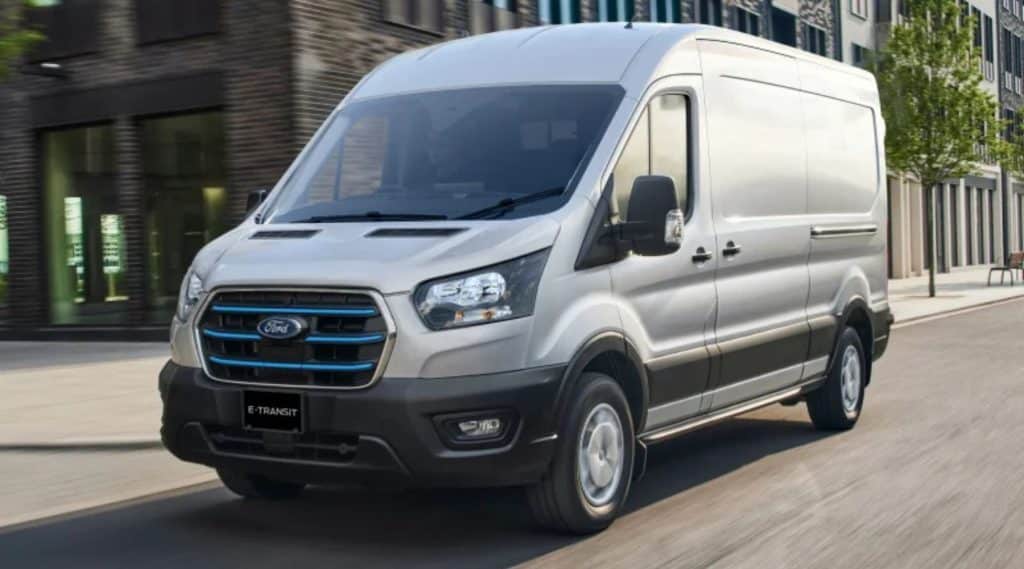
- Minimum and maximum price: from $89,990
- Battery capacity: 68kWh
- Maximum power: 198kW/430Nm
- DC fast charge time (15% to 80%, 115kW): approx. minimum 34 mins
- Payload: up to 1,611kg (E-Transit Mid-Roof)
- Load volume: up to 12.4m3 (E-Transit High-Roof)
- Wheelbase: LWB (3,750mm)
- Range: up to 307km
Formerly the costliest van of the five, the E-Transit from American carmaker Ford has dropped in price by $15,000 over the past few years to now set you back at least $89,990. It comes in only one trim, with the option for either a lower Mid-Roof or a High-Roof. It’s larger than any of the other vans listed by some distance, with a wheelbase clocking in at 3750mm and a total overall height of up to 2790mm.
As you’d expect, the payload and load volume reflect this increased size, with up to 1,611kg able to be carried by the E-Transit (Mid-Roof) and a total load volume of up to 12.4m3 (E-Transit High-Roof). With its 68kWh battery, it’s also capable of a maximum power output of 198kW and torque of 430Nm, as well as an impressive 307km range.
The following safety technologies are included as standard:
- Blind Spot Monitoring System (BLIS)
- Load Adaptive Control
- Remote Keyless Entry with two fobs
- Lane Keeping Aid with Lane Departure Warning
- Dynamic Stability Control (DSC) incorporating ABS
On top of this, drivers can make use of a Floating 12-inch Capacitive Touch Screen, SYNC4 Connectivity System with Applink, FordPass Connect with Embedded Modem, satellite navigation and more. If you or your business is in a position to fork out for the E-Transit, it could offer the space and convenience you’re looking for.
2. Peugeot e-Partner
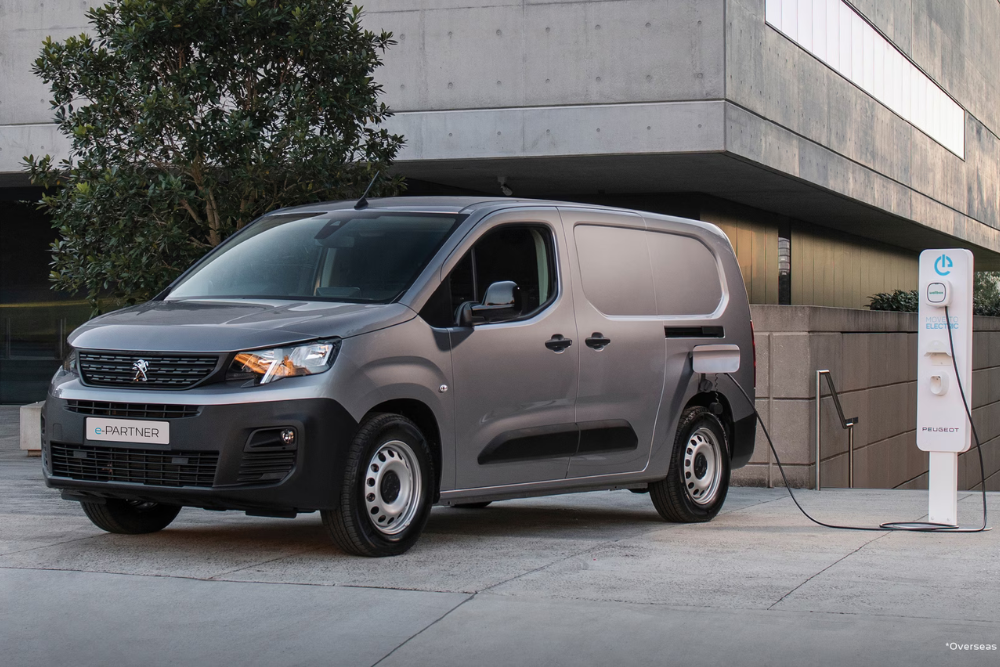
- Minimum and maximum price: from $59,990
- Battery capacity: 50kWh
- Maximum power: 100kW/260Nm
- DC fast charge time (0% to 80%, 100kW): approx. minimum 30 mins
- Payload: up to 750kg
- Load volume: 3.9m3
- Wheelbase: LWB (2,975mm)
- Range: up to 258km
If you’re shopping for an EV in the commercial van space, there are several options to choose from. One of the cheapest electric vans in Australia right now is the Peugeot e-Partner, which is a variant of the Partner Van range that comes with a starting price of $59,990.
On the smaller end of the electric van market, the e-Partner comes with a payload of up to 750kg and 3.9m3 of loading volume on the back of its 50kWh battery, which is capable of producing up to 100kW of power. It contains all the safety features offered across the Partner range, plus some electric-exclusive ones, including:
- Hill Start Assist
- Advanced Driver Attention Alert (DAA3)
- Active Lane Keep Assist
- Autonomous Emergency Braking (AEB)
- Acoustic Vehicle Alerting System (AVAS), which produces external sound when travelling at low speed for pedestrian safety
- 180° colour reversing camera
You can also enjoy an 8-inch capacitive central touchscreen, 3D Satellite Navigation, DAB radio, Apple CarPlay, Android Auto, voice recognition and more.
3. Mercedes-Benz eVito
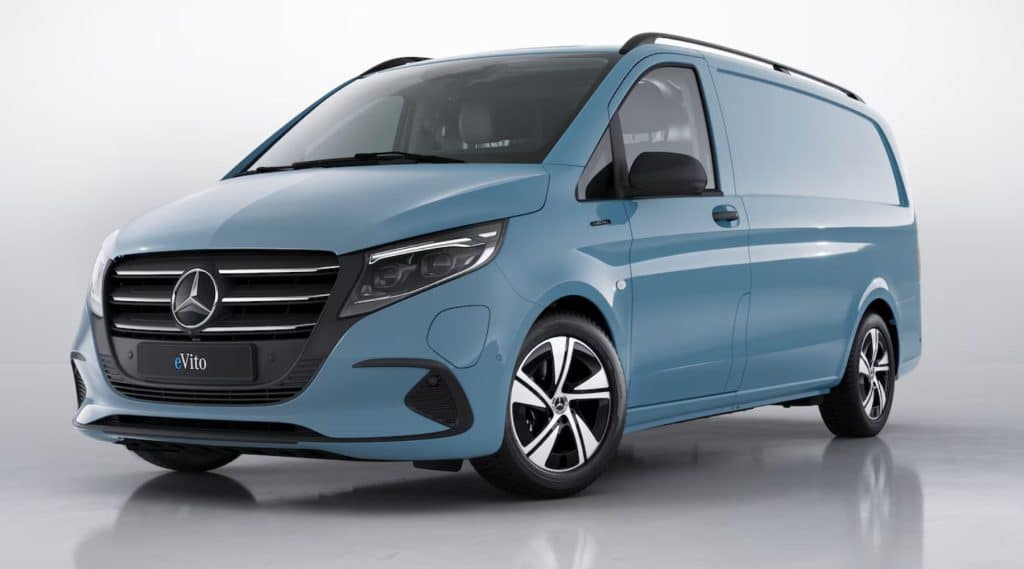
- Minimum and maximum price: from $98,951
- Battery capacity: 60kWh
- Maximum power: 85kW/360Nm
- DC fast charge time (10% to 80%): approx. minimum 35 mins
- Load volume: 6.6m3
- Wheelbase: MWB (3,200mm)
- Range: up to 283km (NEDC testing)
The most expensive van on this list, the eVito from Mercedes-Benz finds itself in the middle of the five vans here in terms of size, with its single medium wheelbase (MWB) trim giving it a load volume of 6.6m3. However, Mercedes-Benz doesn’t disclose the maximum payload for the eVito publicly.
Mercedes-Benz’s listed range for the eVito is 283km, but this is based on the NEDC form of testing, with the WLTP-standard range not cited. However, the German manufacturer does claim that the van can be fully charged from 10% to 80% in just 35 minutes with a fast DC charger.
In terms of safety, it comes with a suite of assistance technologies, such as:
- Active Distance Assist DISTRONIC
- Active Lane Keeping Assist
- Blind Spot Assist
- Active Brake Assist
- Lane Keeping Assist
- Traffic Sign Assist
At an entry price of $98,951, it won’t be affordable for every small or medium business, but the eVito brings a touch of luxury to your commercial van, both in terms of its features and its modern, premium interior.
4. Renault Kangoo E-Tech

- Minimum and maximum price: from $61,990 to $63,990
- Battery capacity: 45kWh
- Maximum power: 90kW/245Nm
- DC fast charge time (0% to 100%, 80kW): approx. minimum 85 mins
- Payload: up to 668kg (Kangoo E-Tech LWB)
- Load volume: up to 4.2m3 (Kangoo E-Tech LWB)
- Wheelbase: SWB (2,716mm) and LWB (3,100mm)
- Range: up to 286km (all variants)
Renault’s Kangoo E-Tech is another competitor in the cheaper small van market alongside the e-Partner. At a starting price of $61,990 for the SWB variant and $63,990 for the LWB, it sits at a similar (but slightly higher) price compared to its Peugeot counterpart.
Its battery is slightly lower-power at 45kWh, allowing it to reach up to 90kW (10kW lower), but its range is listed at 286km, which is 28km better than the e-Partner. It also comes with a lower maximum payload of 668kg but higher maximum load volume of 4.2m3.
The Kangoo E-Tech comes with an Easy Link 8-inch capacitive touchscreen multimedia system and Apple CarPlay & Android Auto smartphone replication, as well as the following safety features:
- Rear parking sensors
- Reversing camera
- Advanced Emergency Braking System
- Lane Keep Assist and Lane Departure Warning
- Low tyre pressure warning
However, there are several packs that can be added to your Kangoo E-Tech for an extra cost. This means features such as adaptive cruise control, Blind Spot Intervention, front and side parking sensors and wireless smartphone charging are effectively locked behind a paywall.
5. LDV eDeliver 7
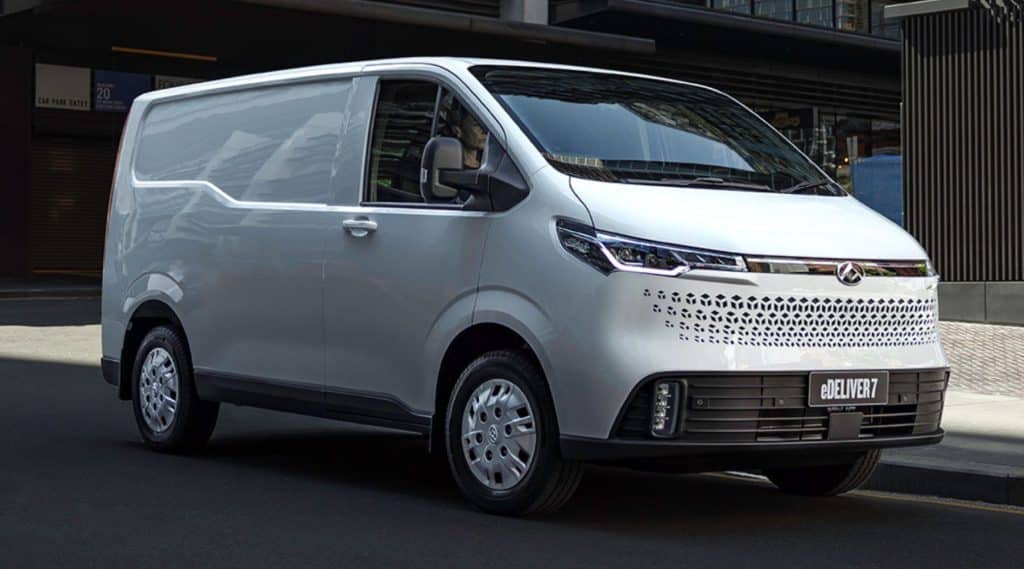
- Minimum and maximum price: from $67,358 to $73,674
- Battery capacity: 77kWh to 88kWh
- Maximum power: 150kW/330Nm
- DC fast charge time (20% to 80%, 90kW): approx. minimum 43 mins
- Payload: up to 1,350kg (eDeliver 7 SWB Low Roof)
- Load volume: up to 8.7m3 (eDeliver 7 LWB High Roof)
- Wheelbase: SWB (3,000mm) and LWB (3,366)
- Range: up to 362km (eDeliver 7 LWB Low Roof)
The eDeliver 7 from, Chinese manufacturer LDV, has moved up a rung in terms of price to a cost over $7,000 more than the e-Partner. However, the one-tonner comes in four trim levels, incorporating both SWB and LWB models and short and high roofs, as well as two different batteries: a 77kWh and 88kWh one. This means you’re getting more “oomph” on the road, not to mention better range at up to 362km, behind the wheel of an eDeliver 7.
The option to choose between different sizes and heights allows buyers to customise their vehicle to their liking, with the SWB Low Roof starting from a cargo volume of 5.9m3 and the top trim LWB High Roof increasing this to 8.7m3. This is thanks in large part to the 366mm increase in cargo area length and 400mm increase in height.
Some of the safety and convenience features of the eDeliver 7 include (on all trims):
- Emergency Lane Keep Assist (ELKA)
- Speed Limit Sign Identification
- Intelligent Headlight Control
- Fatigue Reminder
- Reverse Camera
- 12.3-inch Touch Screen Infotainment Display with DAB Radio & Bluetooth
- Keyless Entry and Start with Proximity Smart Key
There’s no doubt the eDeliver 7 makes an impressive case as a mid-sized electric van at a competitive starting price.
Other EVs coming soon
Hyundai Elexio
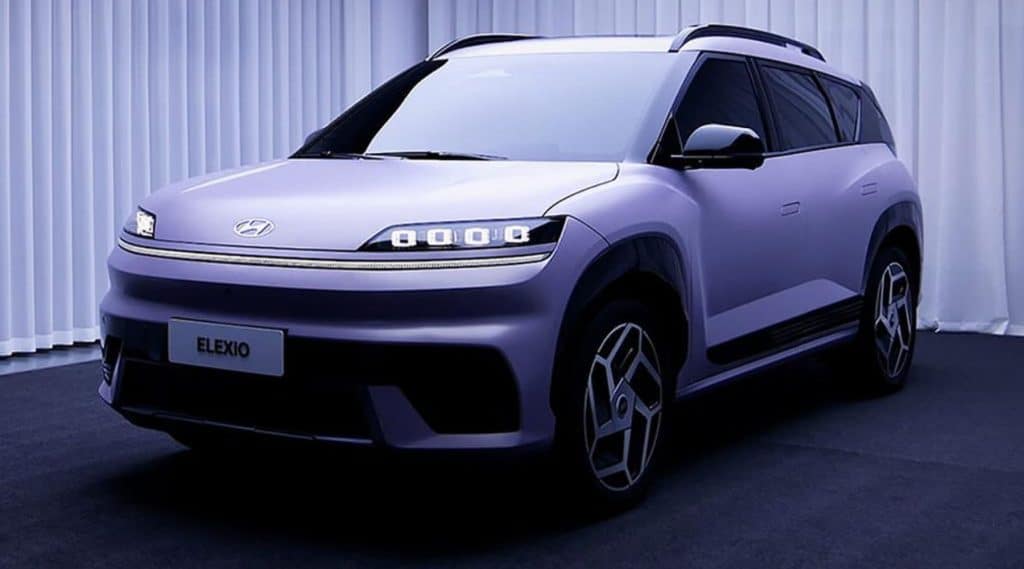
The latest electric SUV to hit the market, the Elexio is the product of collaboration between Hyundai and its Chinese arm, Beijing Hyundai, for the Chinese market. Australia will be a beneficiary of this internal partnership, as the Elexio will be reaching our shores in early 2026.
Honda Super-ONE
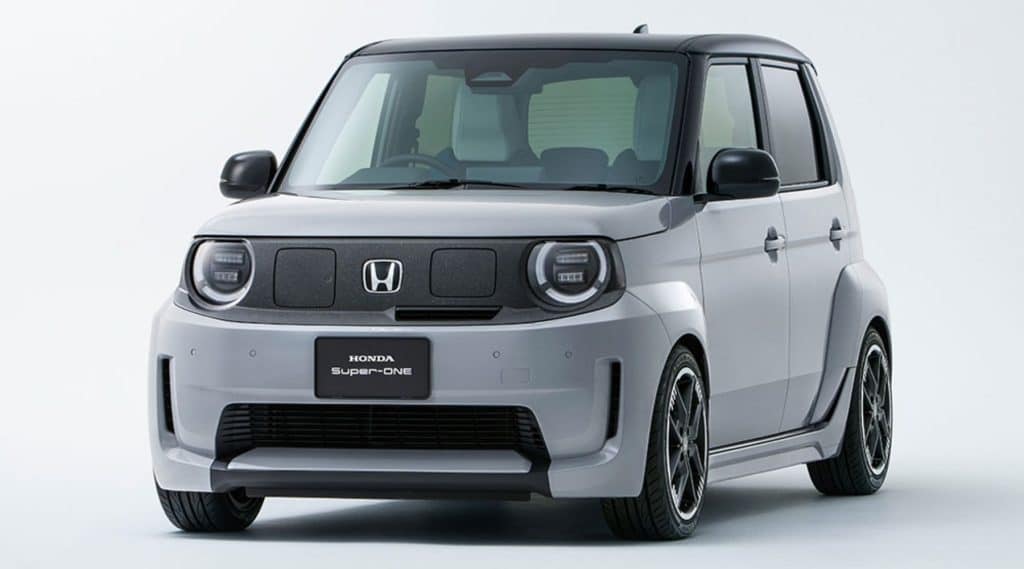
Honda has unveiled what's likely to be one of the smallest EVs on Australian roads in the Super-ONE. This super-small hatch is designed for city drivers rather than long-haul car trips. It's expected to land in showrooms in the second half of 2026.
GAC Aion UT
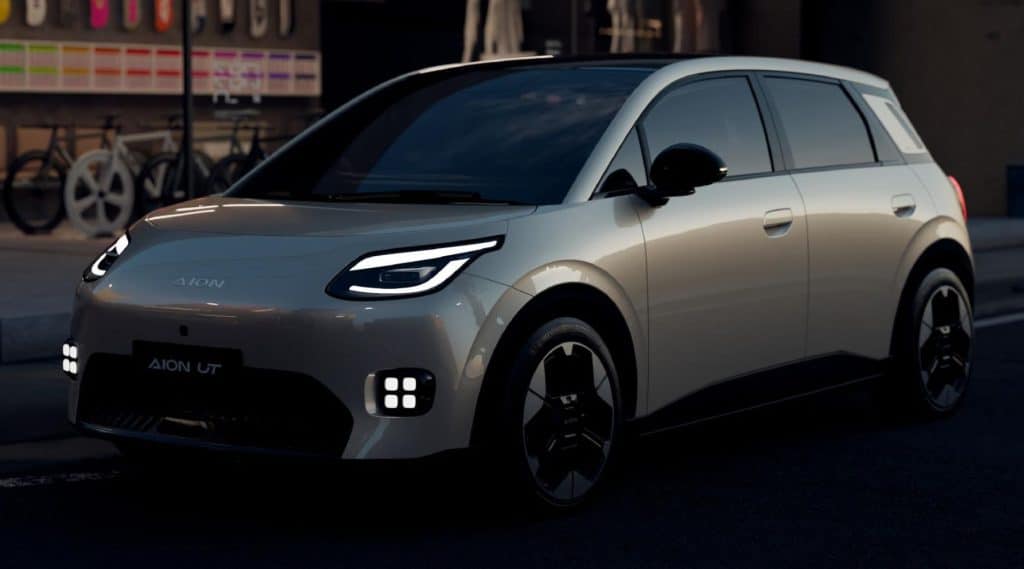
The Aion UT is certainly making waves in China at its basement price point of just $15,466 (US$9,600). The budget hatch would blow current competitors like the BYD Dolphin and GWM Ora out of the water if it reached our shores at a similar starting price.
GAC's Aion V went on sale in Australia in November 2025, with orders open for the budget electric SUV starting from $42,590 before on-road costs.
Land Rover Range Rover Electric
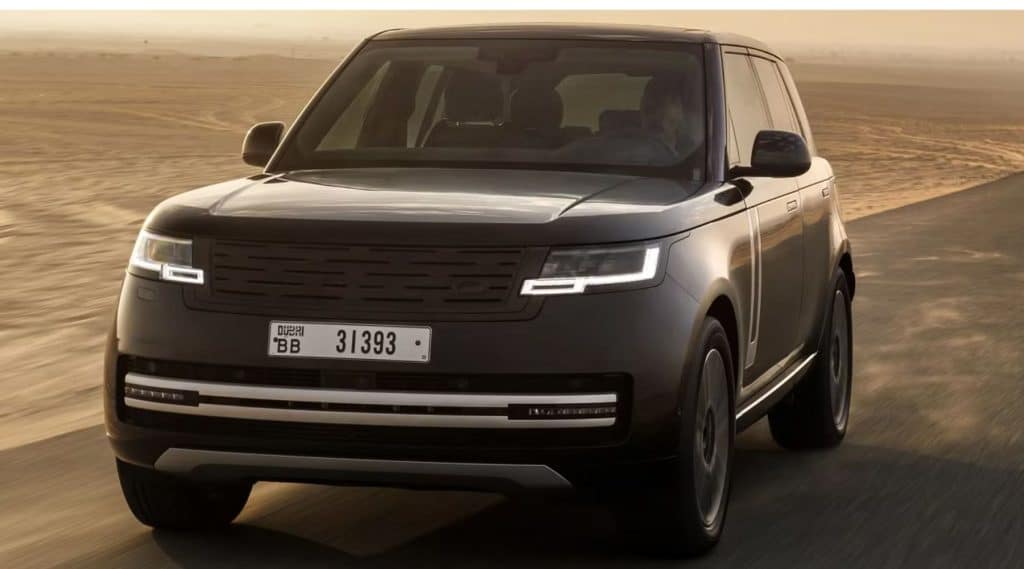
The first fully electrified Land Rover model, the Range Rover Electric, is in its waitlist phase as of November 2025. The official release date for Australia won’t be confirmed until the model’s official launch in late 2025. Not much is known about the vehicle’s specs yet, but you can expect a luxurious, powerful ride if it’s anything like Land Rover’s hybrid offerings.
Nissan Leaf

One of the original trendsetters when it came to electrified vehicles, the Nissan Leaf is set to return to Australia in 2026 or 2027 as an SUV instead of its trademark small hatchback frame. Nissan have given it a thorough facelift and amped up its power and performance, with an estimated 600km or more in potential range.
Polestar 5

A continuation of Polestar’s growing line of luxury EVs, the Polestar 5 sedan has been spotted testing in Australia in H1 2025 ahead of its global launch. It isn’t expected to go on sale in Australia until at least a fair way into 2026, though.
smart #5
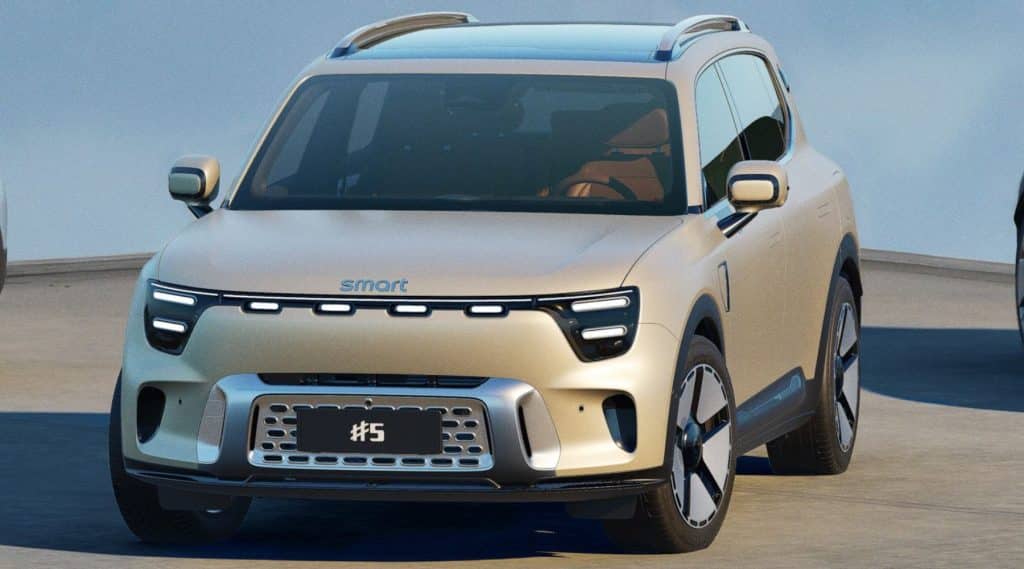
smart, owned jointly by Mercedes-Benz and Geely, has unveiled the #5 mid-size SUV, which is set to go on sale in late 2025. It marks part of their return to our shores, having first appeared in the early 2000s before disappearing after just over a decade. While they were known at that time for their very small two-seater models, they’ve now branched out into SUVs like the #5.
Best-selling PHEVs in Australia: YTD 2025
| Rank | Vehicle | October YTD sales |
|---|---|---|
| 1 | BYD Shark 6 | 15,181 |
| 2 | BYD Sealion 6 | 7,453 |
| 3 | Mitsubishi Outlander | 3,705 |
| 4 | GWM Haval H6 | 2,016 |
| 5 | Mitsubishi Eclipse Cross | 997 |
| 6 | BMW X3 | 973 |
| 7 | GWM Cannon Alpha | 973 |
| 8 | Mazda CX-60 | 926 |
| 9 | Mazda CX-80 | 863 |
| 10 | Ford Ranger | 850 |
| Source: Federal Chamber of Automotive Industries and Electric Vehicle Council | ||
- 2025 BYD Atto 1 and 2025 BYD Atto 2 priced - carsales
- 2025 MG ES5 revealed as ZS EV successor – UPDATED - WhichCar?
- Tesla Model Y - ANCAP Safety
- 2025 Volvo EX40 price and specs: Renamed XC40 Recharge detailed for Australia - Drive
- MG4 X Power - MG
- Fiat 500e - ANCAP Safety
- BMW i4 - ANCAP Safety
- Ford F-150 Lightning - AusEV
- SPY PICS: Polestar 5 spotted testing in Oz months before public debut - carsales

